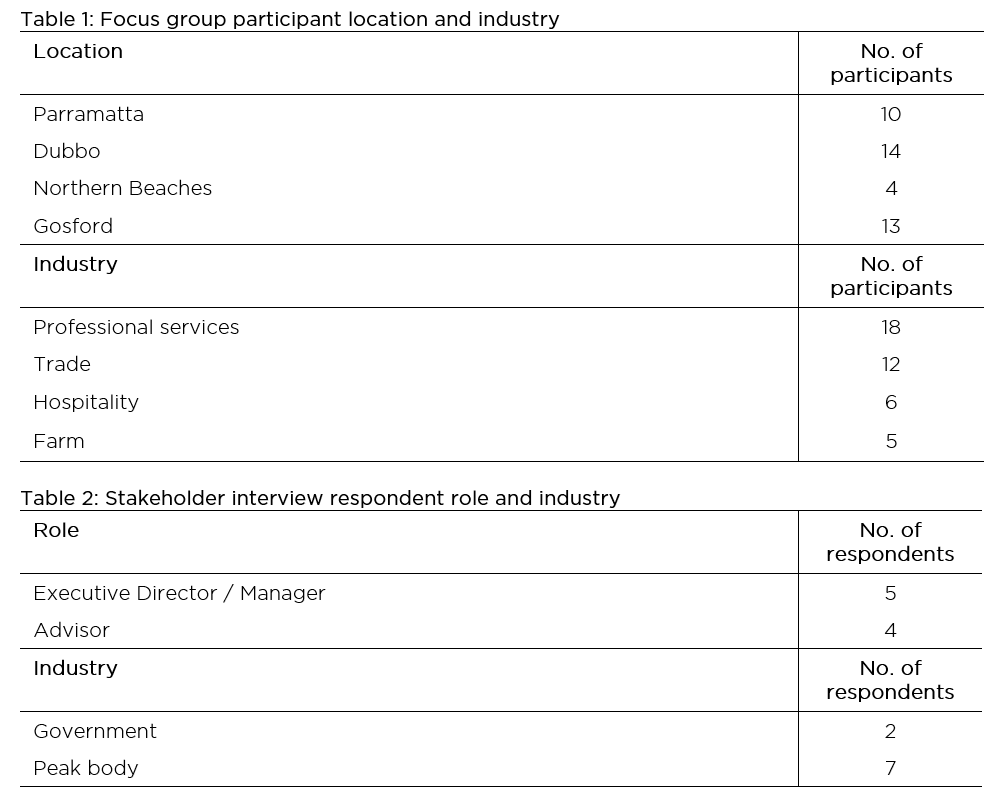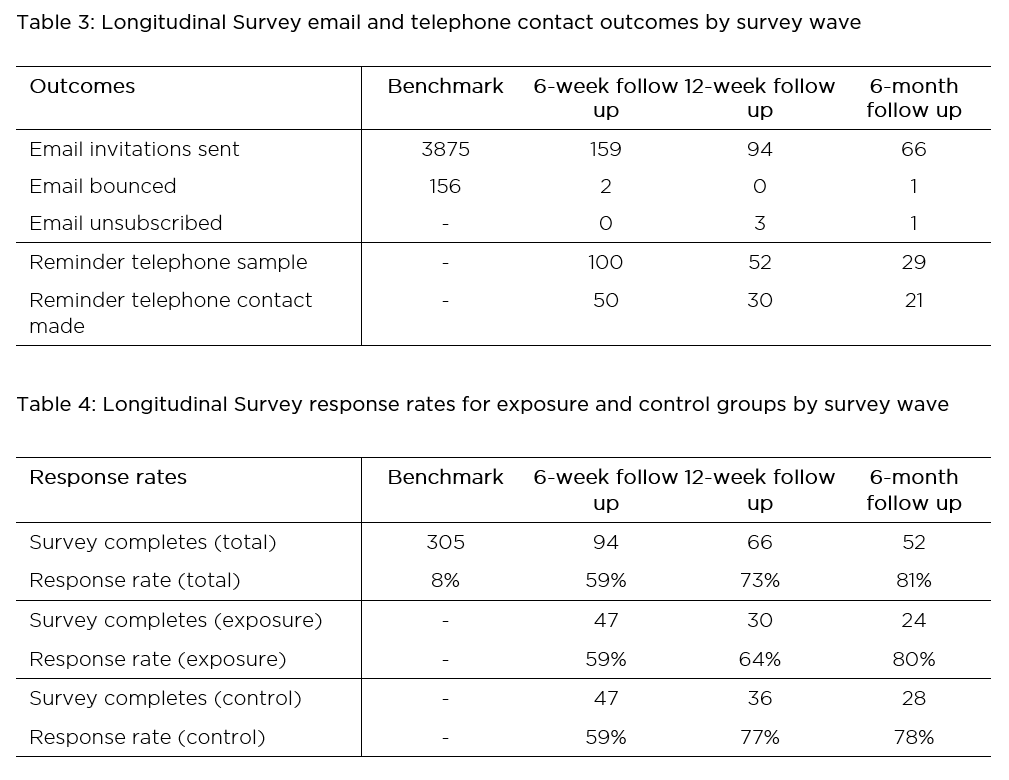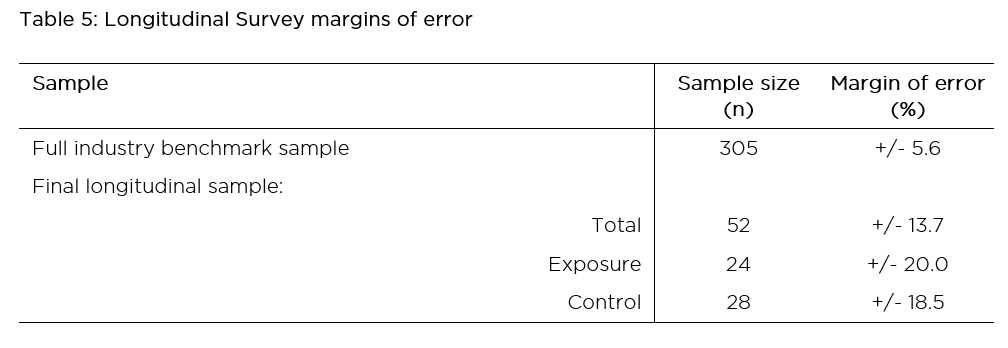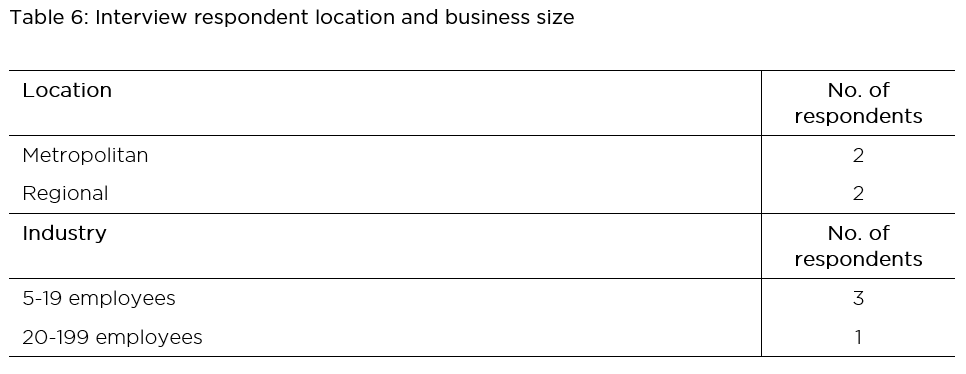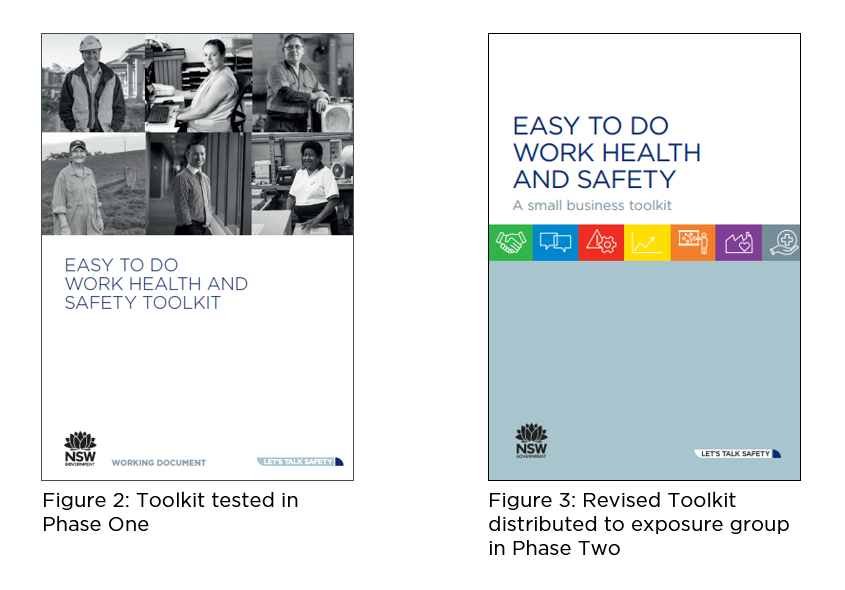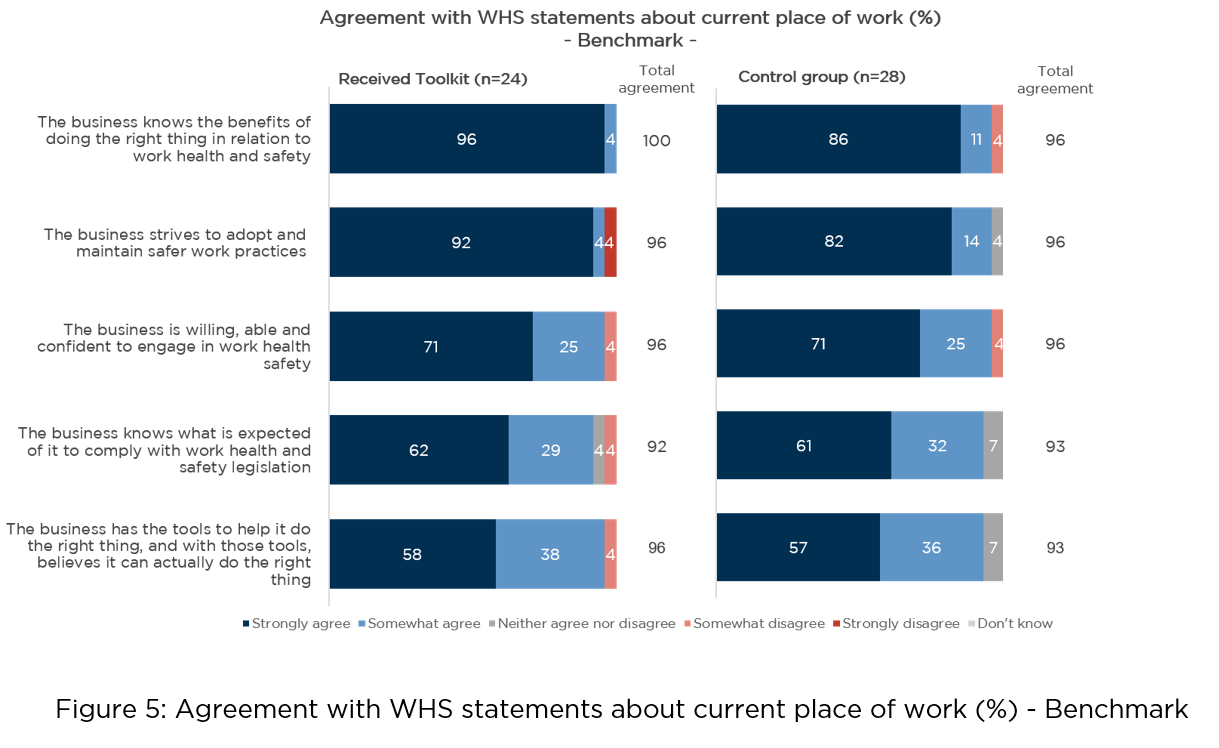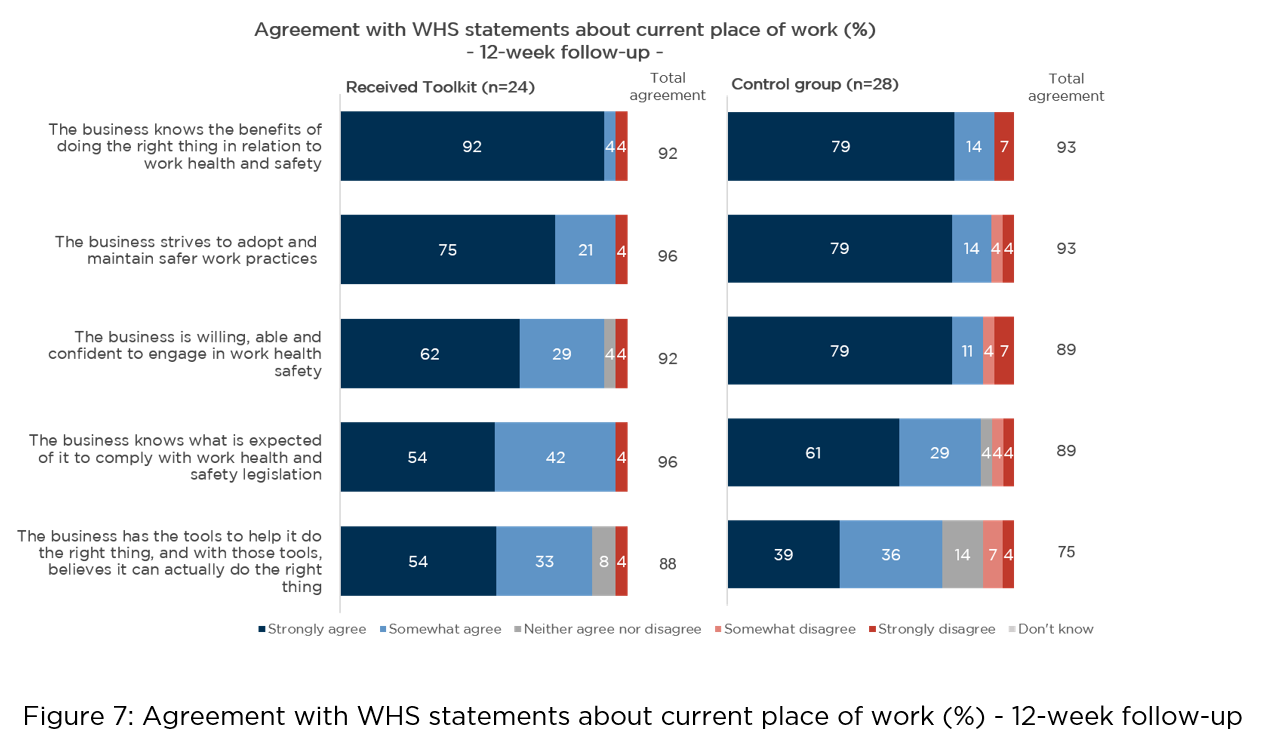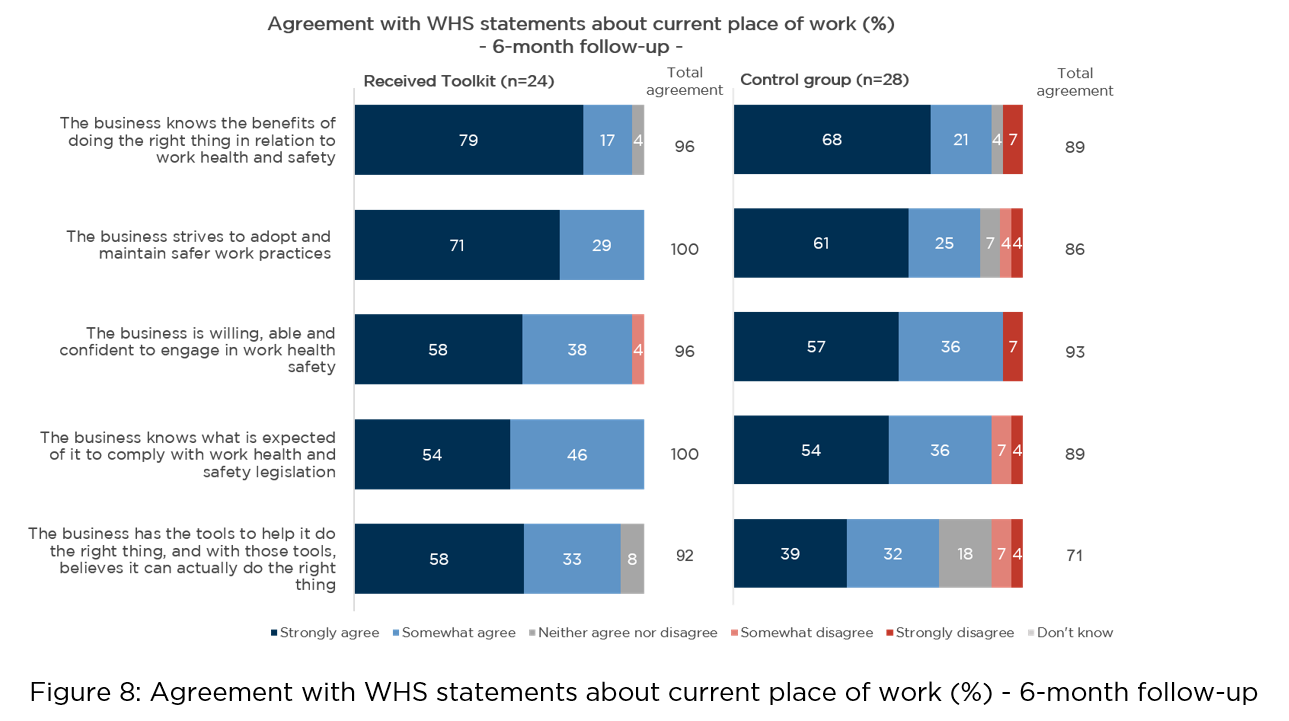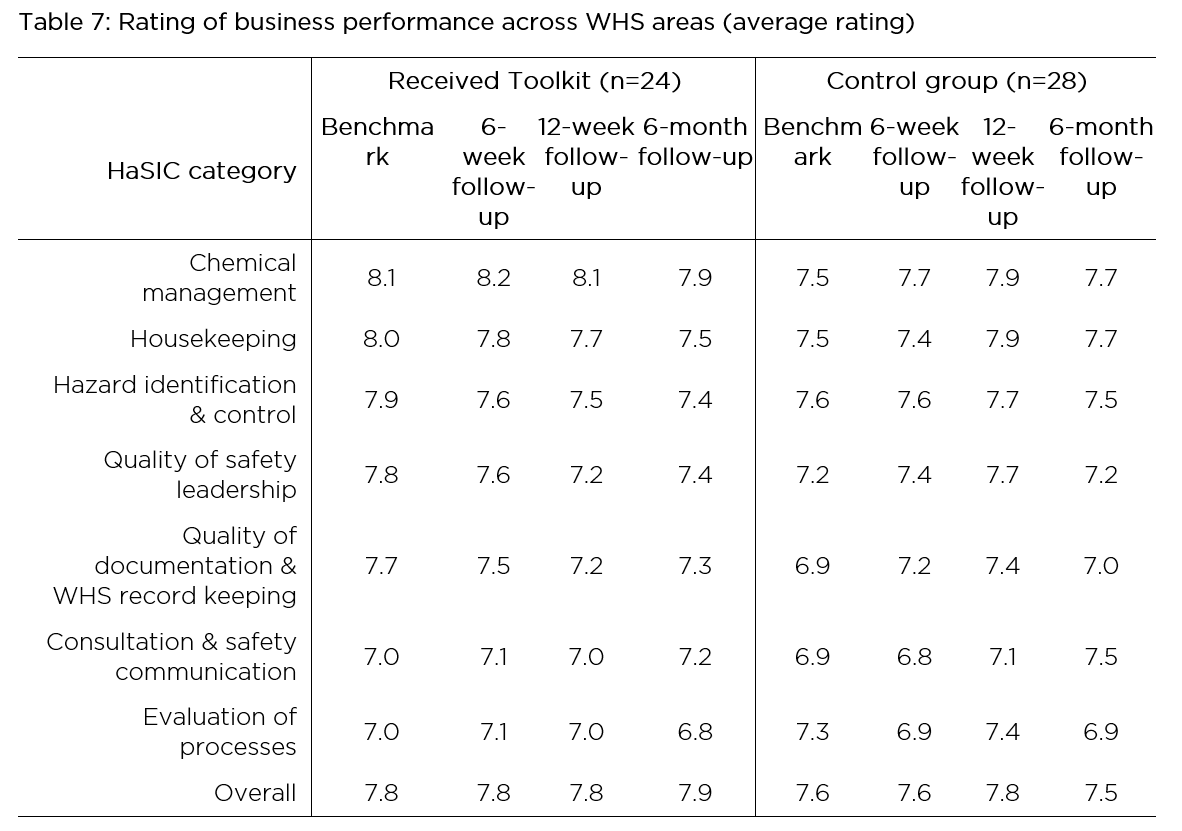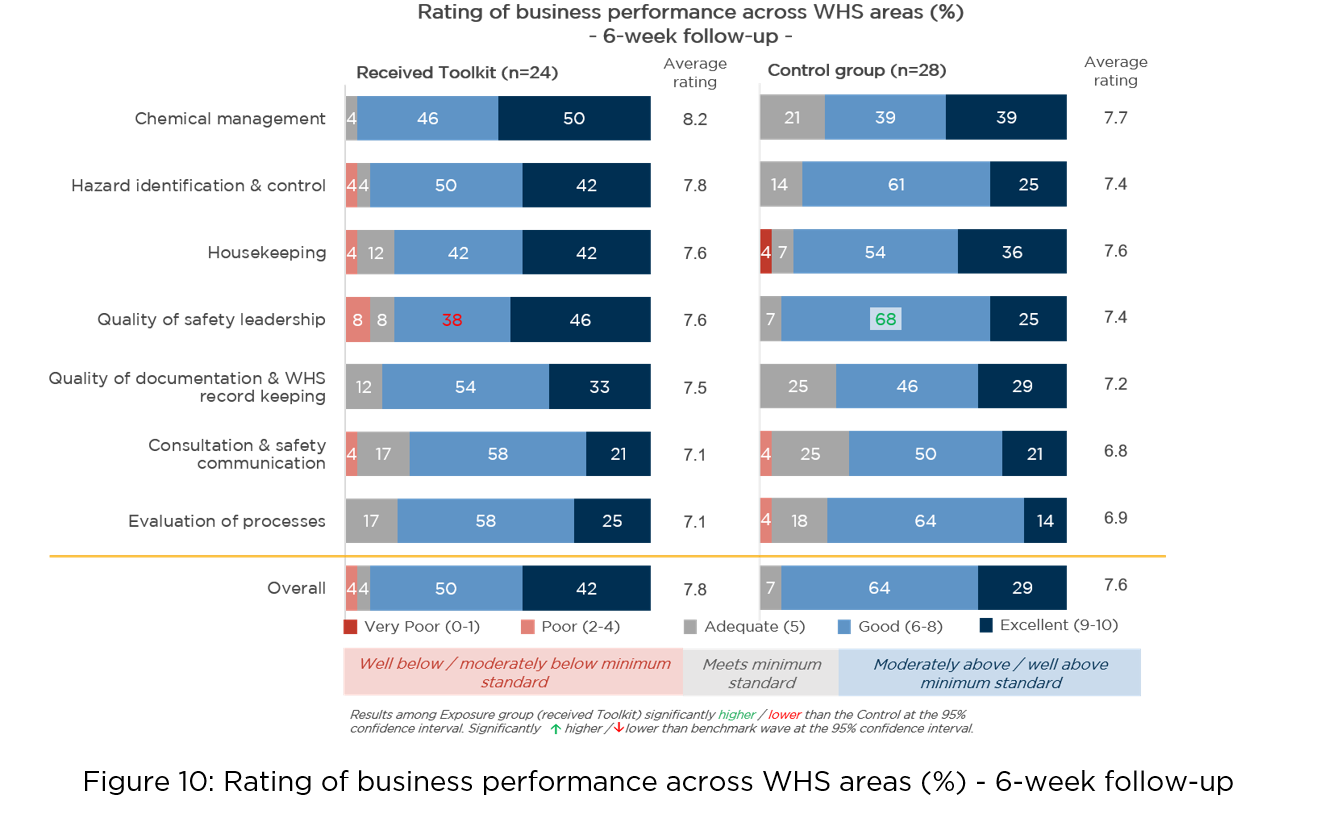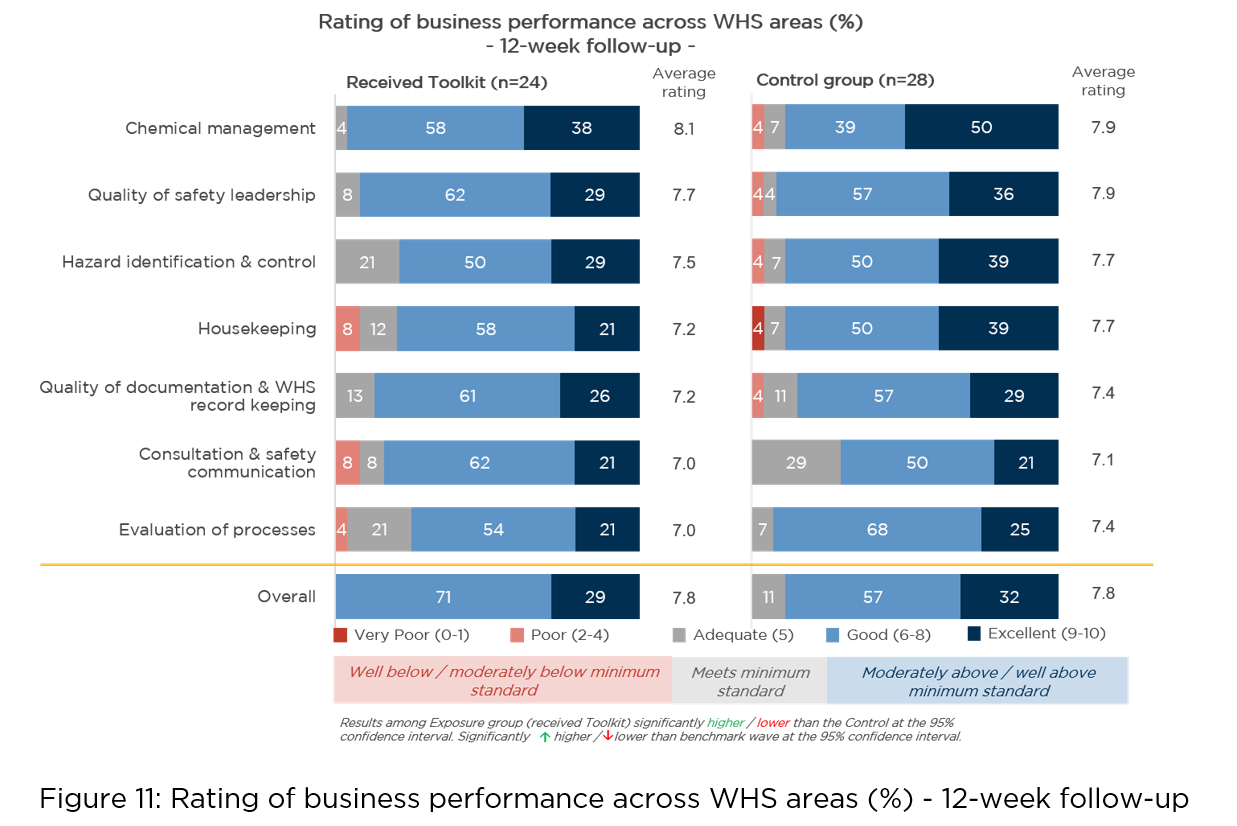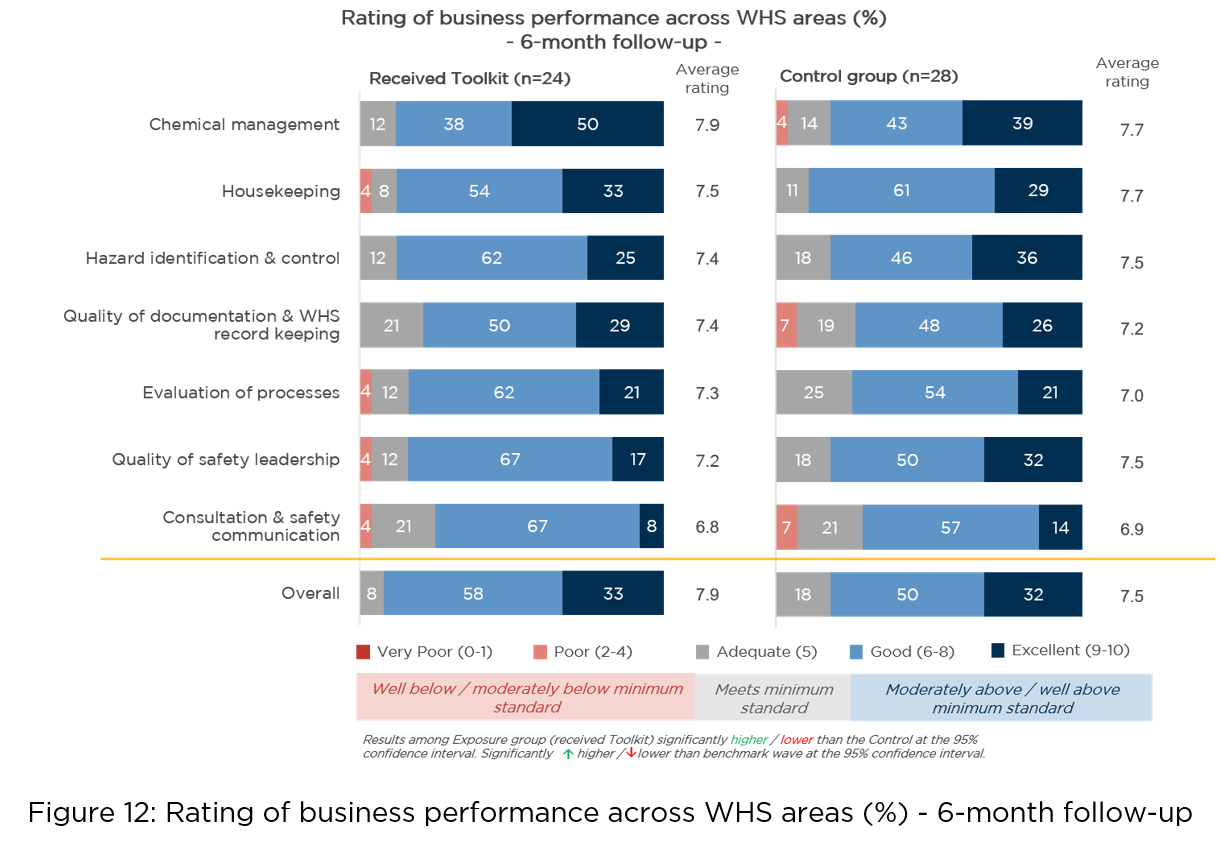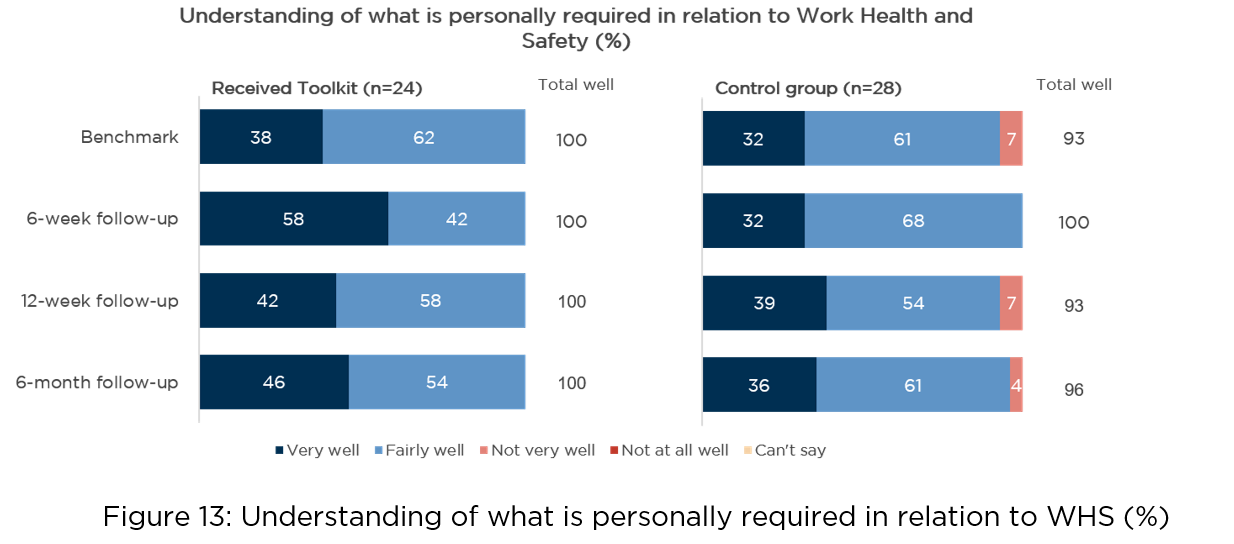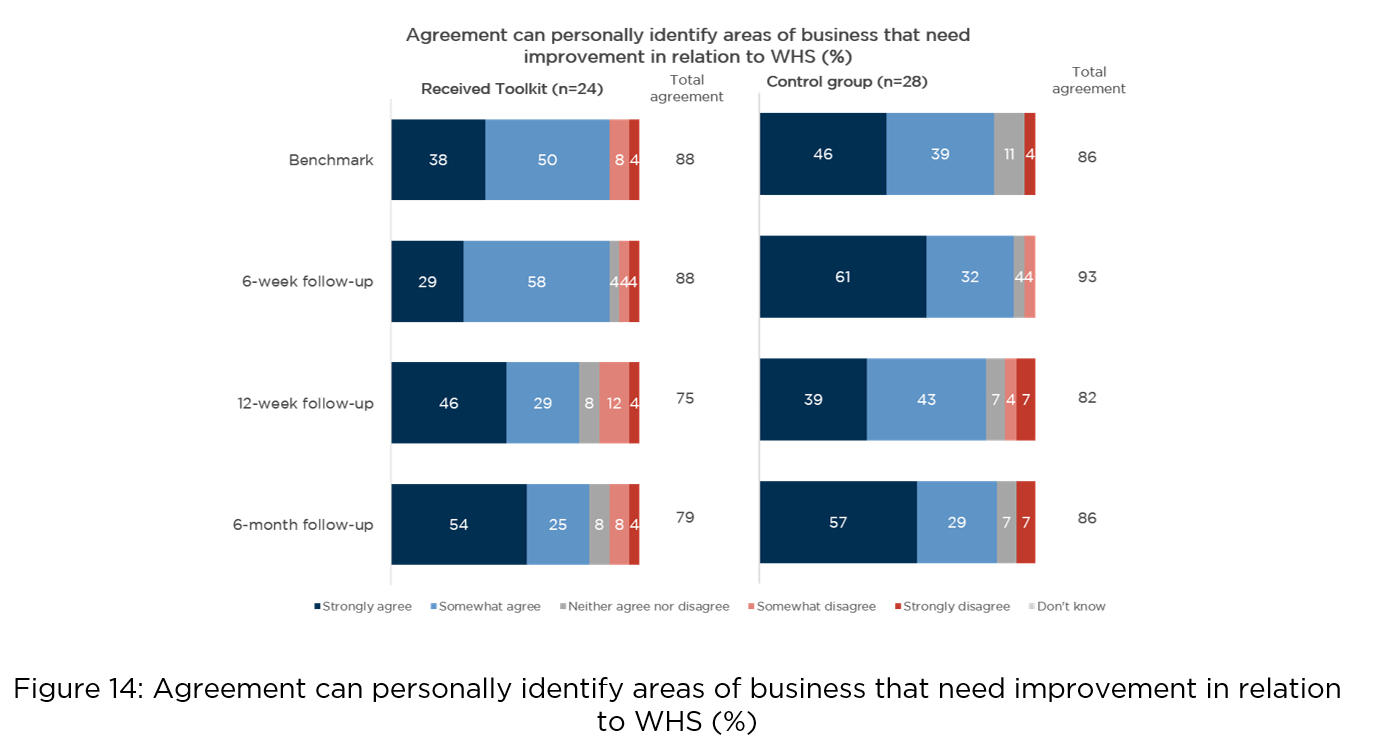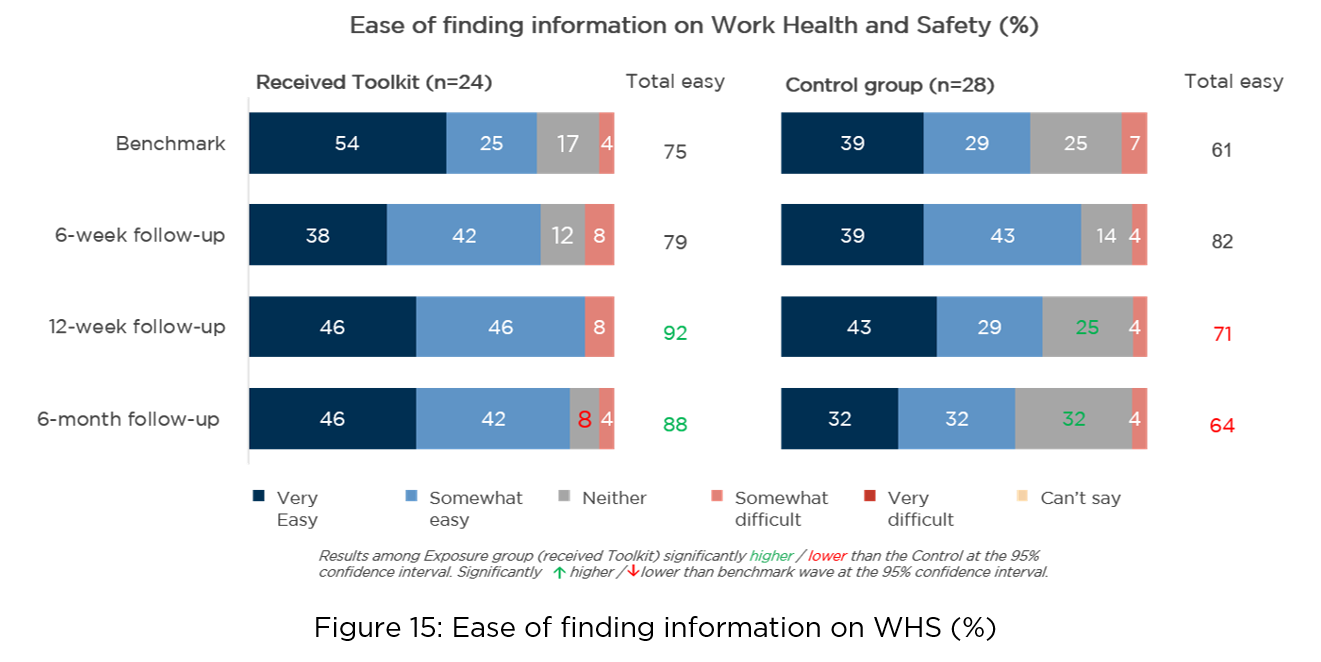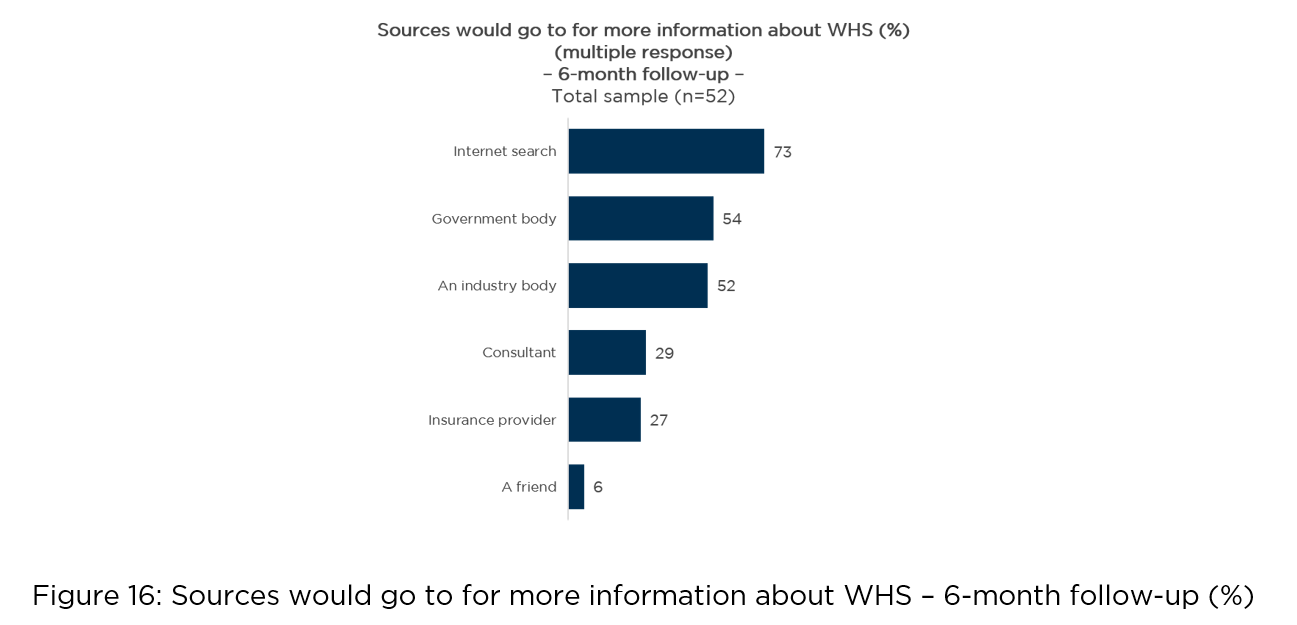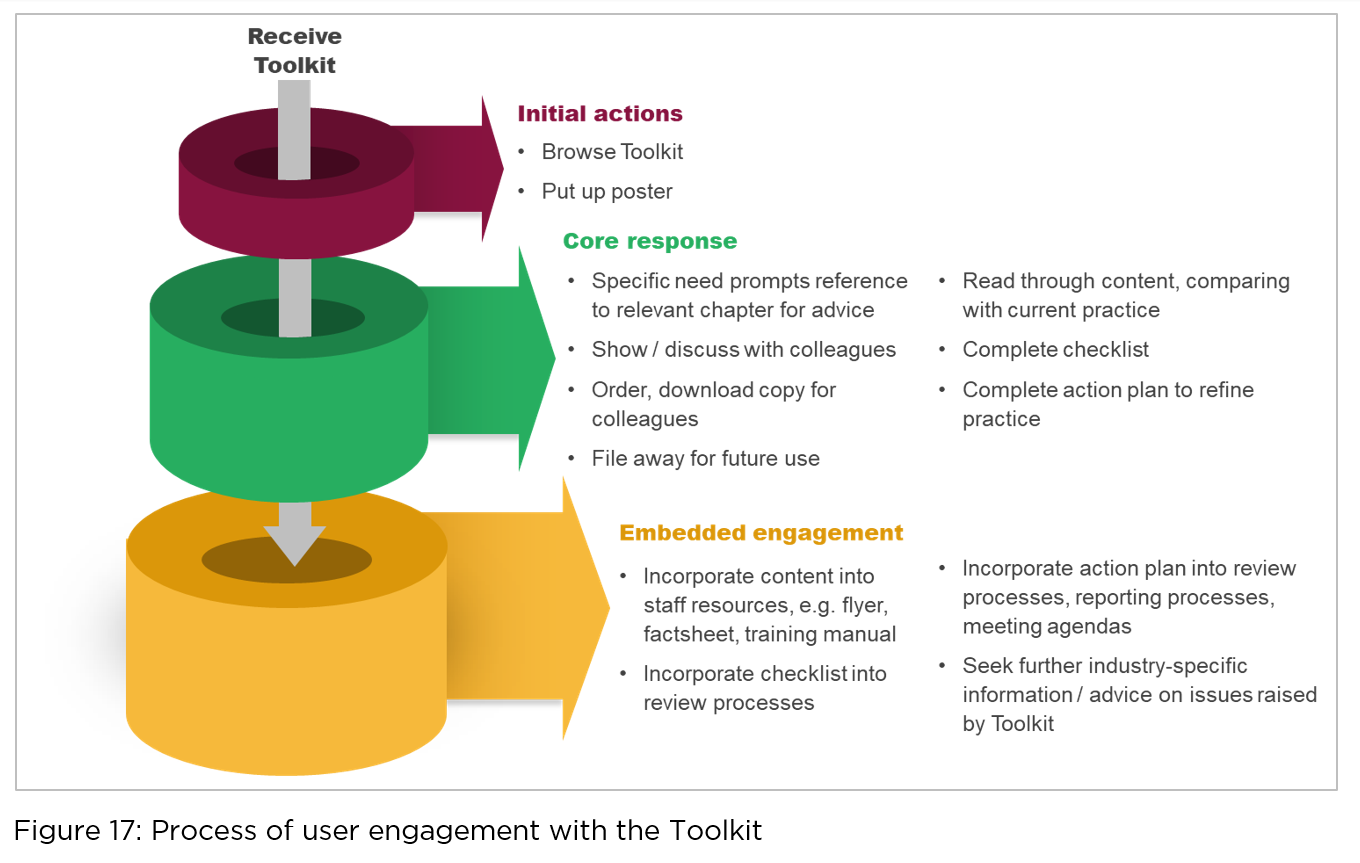Small business initiative 'Easy to Do' Toolkit report
For the PDF version click here.
Executive summary
Background and method
While all NSW businesses are required to comply with work health and safety (WHS) legislation, lack of time, resources and understanding of requirements among small business contributes to limited awareness and compliance among this cohort. This is borne out in the highest proportion of major workers compensation claims, total claims costs and fatal claims coming from small business (SIRA, 2017).
The ‘Easy to do work health and safety’ initiative is part of the NSW Government and SafeWork NSW’s commitment to facilitating compliance among small business by providing them with practical assistance to help interpret and apply WHS legislation. As part of this initiative, the Centre for WHS (Centre) was involved in developing an ‘Easy to do WHS’ Toolkit for small business, that aimed to make WHS easier to understand and implement.
The Easy to do WHS toolkit is a diagnostic tool to assist small businesses deliver safer workplaces. The toolkit contains an introduction to what good work health and safety practice means for business and is supported by a self-assessment checklist and a tailored action plan to make effective WHS improvements.
The Centre provided front end feedback and behavioural insights to help shape the toolkit and conducted a three-phase research project to refine and evaluate the efficacy of this resource among the target audience.
In Phase One, seven discussion groups were undertaken among NSW small business employees across a range of industries, in addition to in-depth interviews among nine government and industry stakeholders. The research gathered feedback on the format and content of the Toolkit, and refinements were made to each as a result.
In Phase Two, a longitudinal online survey was undertaken among a final sample of 52 NSW childcare centre employees. The research measured changes in WHS awareness, attitudes and behaviours among an exposure group who received a copy of the Toolkit after an initial benchmark survey versus a control group at six-week, 12-week and six-month intervals.
In Phase Three, follow up in-depth interviews were undertaken with four Toolkit recipients from the longitudinal exposure group to gather more detailed user feedback on the form, content and efficacy of the updated Toolkit in making it easier for small business to do WHS.
Discussion and recommendations
Among the small business focus groups and stakeholder interviews, it was acknowledged that WHS is an important issue and all staff have a role to play. Employees were generally seen to understand the basics of what they must do in relation to WHS, and it was seen as management’s role to understand the relevant legislation and provide employees with continual education and support in this area. However, in the case of a franchisee participant, standardised WHS policy, procedures and materials were set at ‘head office’ level, thus limiting input from individual site managers and staff. Overall, the key barrier to increasing their efforts in WHS was the perceived time required to stay up to date on WHS. Complicated compliance processes, ever-changing legislation, excessive paperwork, preparation time for external audits, and the need to communicate changes and train employees along the way were cited as examples of the time-consuming (and therefore costly) nature of WHS.
Qualitative feedback during pre-testing and follow-up interviews highlighted the potential of the Toolkit as both a strong starting point for businesses needing to set up their WHS regime and an audit and refinement tool for those with policies and processes already in place. It’s clear, simple framework and explanations could be used to talk to management and staff about WHS regulations and their responsibilities, and to develop or enhance training resources. The Checklist was viewed as useful for regular ‘check-ins’ to identify gaps in knowledge and practice. The Toolkit’s separate chapters were deemed easy to use and valuable for urgent or ad hoc information needs, e.g. dealing with workplace incidents or workers’ compensation cases. The final Action Plan provides a useful tool for management and staff to formalise suggestions and improvements by helping to define actions, resources and timeframes, which can be monitored. More broadly, it was thought the use of the action plan could also encourage better staff habits for thinking about, recording, and acting on WHS issues.
Quantitative survey results provided some indications that the Toolkit contributes to making it easier for small businesses to do WHS. Those who received the Toolkit were significantly more likely to feel WHS information is easy to find than those without the Toolkit. In other encouraging, but not statistically significant, results, more Toolkit recipients felt their workplace had the tools to help it do the right thing, and their understanding of their personal WHS obligations improved in the six weeks after receiving the Toolkit. However, with few statistically significant differences in results over time or between the small exposure and control samples, it is difficult to make conclusions about the true impact of the Toolkit on attitudes and behaviours. A large majority of both the exposure and control groups rated the attitudes and actions of their workplace positively, agreeing the business knew its WHS obligations and the benefits of doing the right thing, had the confidence to engage in WHS and strives toward safer practices. Further, both groups rated their workplace as performing moderately above the minimum standard, on average, across all Monash University Health and Safety Inspector Checklist (HaSIC) categories. Average overall ratings on business’ WHS performance were a little higher at the final follow-up survey among those who received the Toolkit, versus those who did not. Performance on ‘chemical management’ was rated highest, while ‘consultation and safety communication’ and ‘evaluation of processes’ were rated lower, suggesting these are areas where businesses could use more assistance and have room to improve.
Survey results supported qualitative feedback on the importance of providing an online version of the Toolkit and promoting the Toolkit through other Government and industry-specific channels. Most survey respondents indicated they would undertake an internet search if they needed more information on WHS, highlighting the need for an online Toolkit that is picked up through simple search terms and easily accessible links. With half of the survey respondents sourcing WHS information from Government and industry bodies, there are opportunities to provide access to the Toolkit or promote it via these channels. These views were in line with the qualitative feedback, which also supported enhancing the Toolkit’s online features and functionality. In response to this audience feedback and indicative success of the Toolkit, consideration should be given to the following general recommendations:
- Raise awareness of the Toolkit by promoting it to small business through newsletters, social media, events and specific industry channels.
- Facilitate wider access to the Toolkit by developing an online version, ideally with enhanced functionality, such as an interactive checklist and action plan, automatic notifications/reminders, and active hyperlinks to references like related Toolkit sections, additional resources, relevant legislation and external websites.
- Encourage the wider use of the Toolkit by promoting its value as both an information source for businesses establishing their WHS regime, and an internal audit tool for businesses to regularly check and refine their practices.
- Further support best-practice WHS and compliance by developing/promoting supplementary resources such as induction modules, factsheets and videos, and linking these to an online Toolkit. Consideration should be given to preparing or including links to industry-specific material.
- Provide a feedback mechanism for users to suggest new topics, emerging issues or extra resources (e.g. forms, lists, exercises) for inclusion in future updates to the Toolkit.
Background and objectives
While all NSW businesses are required to comply with work health and safety (WHS) legislation, lack of time, resources and understanding of requirements among small business contribute to limited levels of WHS awareness and compliance. Low levels of awareness and compliance can be seen in the highest proportion of major workers compensation claims, total claims costs and fatal claims coming from small businesses (SIRA, 2019)
The ‘Easy to do work health and safety’ initiative is part of the NSW Government and SafeWork NSW’s commitment to facilitating compliance among small businesses by providing practical assistance to help interpret and apply WHS legislation. As part of this, a Toolkit was developed for small businesses to help make work health and safety easier to understand and easier to do.
The Easy to do Work Health and Safety toolkit is a diagnostic tool to assist with their capability to deliver safer workplaces. It is designed to make it easier for small businesses to understand what good health and safety looks like and how to achieve this in their workplace. The toolkit presents clear, plain English, assessment resources for business to evaluate their operation against their WHS obligations and identify shortfalls.
The kit contains an introduction to what good work health and safety practice means for business and is supported by a self assessment checklist that businesses can use to rate themselves against seven key elements of a simple work health safety management system:
- Management Commitment
- Consultation and Communication
- Managing risks
- Reporting
- Worker capability
- Safe Working environment
- Protecting injured workers
The accompanying advice then provides specific guidance on how to improve in areas where ratings were not optimal. This allows the business to create a tailored action plan (template included in hard copy or available online) to make effective WHS improvements.
The Easy to Do WHS is also available on a digital platform. Businesses can complete an online assessment and generate an action plan that can be saved in their own business systems and updated regularly as actions are undertaken. There are a rapidly growing number of links available from the digital product that ensures the information provided to businesses is up-to-date.
The Centre for Work Health and Safety (Centre) conducted a three-phase research project to refine and evaluate the efficacy of this resource among the target audience.
The objective of Phase One was to test the Toolkit among end-users to further refine the resource and maximise its potential impact, specifically to:
- Test whether the Toolkit is easy to use, follow and understand
- Assess the effectiveness of the Toolkit’s ability to make it easier to understand WHS regulations, comply with WHS regulations and make it easy to implement WHS in the workplace
- Ensure the content is relatable to small businesses
- Verify that the Toolkit is functional in everyday life and would be used
- Evaluate the overall look, feel and layout of the Toolkit.
The objective of Phase Two was to measure changes in small business WHS attitudes and behaviours over a six-month period, following their exposure to the final Toolkit resource, specifically in their perceptions of:
- WHS awareness and attitudes within the business
- Business performance in relation to WHS (using the Monash University Health and Safety Inspector Checklist)
- Ease of finding WHS information.
The objective of Phase Three was to gather feedback from Toolkit users, specifically on:
- Current WHS practices and approaches within the business
- Reactions to and use of the Toolkit, including any barriers to implementation
- Impact of the Toolkit on WHS within the business
- Potential enhancements and approaches to promoting the Toolkit.
Method
Phase One: Pre-testing of Toolkit among NSW small businesses and government/industry stakeholders
Seven face-to-face focus group discussions were conducted among NSW small businesses to identify and explore responses to the hardcopy Toolkit in depth. Discussions lasted up to one hour and 45 minutes in duration and were conducted on the 18th and 19th July 2018. In addition, nine stakeholder interviews of 30 minutes were conducted via telephone over the 13th to 18th July 2018 to gather input from key government and industry stakeholders. Recruitment of participants came from a variety of industries and metropolitan and non-metropolitan locations.
The group discussion guide and stakeholder interview guide are included in Appendix A and B.
Phase Two: Longitudinal survey of Toolkit recipients (NSW childcare businesses)
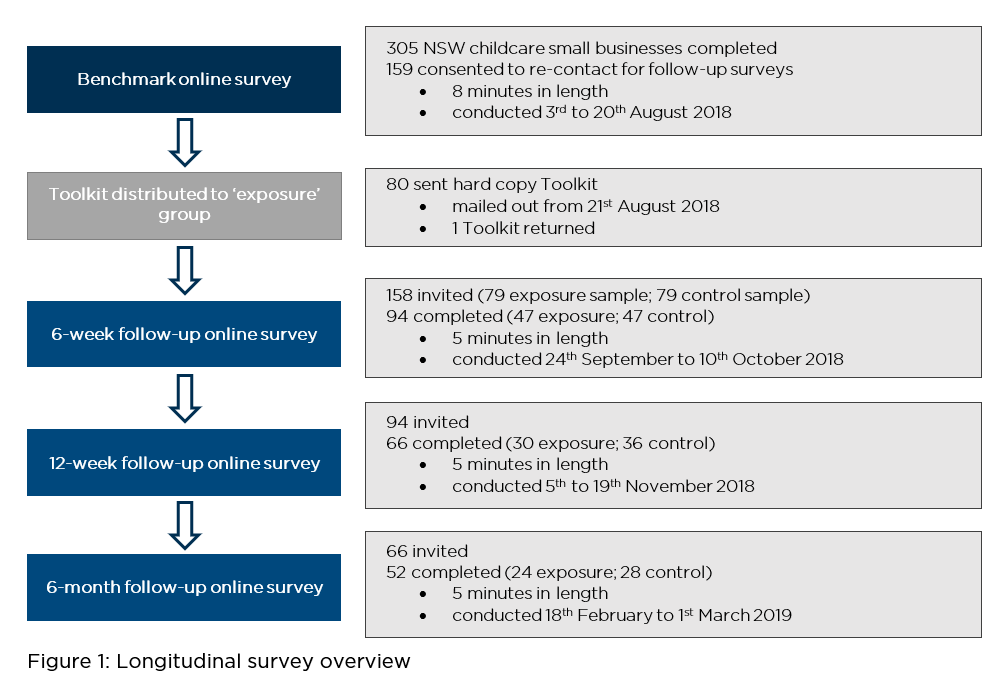
Recruitment of participants for the Benchmark wave was conducted by inviting a sample of small-to-medium NSW childcare businesses to participate in an initial online survey. Participants were recruited from both metropolitan and non-metropolitan based businesses.
After completion of the Benchmark survey, those who consented to further follow-up, were randomly assigned to an exposure (n=80) or control (n=79) group. A hard copy of the Toolkit was mailed to the exposure group. One Toolkit was undeliverable, and that respondent/centre was removed from the study, reducing the final exposure sample to 79. The control group didn’t receive a Toolkit.
Note that, while the Toolkit was launched publicly in October 2018 (i.e. during the 6-week follow-up fieldwork), the control group among the final longitudinal cohort (n=28) had no substantive exposure to it:
- n=1 claimed to have received or downloaded the Toolkit but had not used it (i.e. had not read or looked through it, acted on its information, or shared it with colleagues)
- a further n=6 claimed only awareness of the Toolkit.
One survey login was provided per childcare centre, allowing only one staff member to complete the survey. Measures were taken to ensure, as much as possible, that the same individual at each centre undertook each wave of the survey (e.g. through personalised invitations, reminder emails and phone calls). Surveys completed by other individuals within the business were accepted, although these were very few in number and limited to the 6-week (n=4) and 12-week (n=1) follow-up surveys.
To maximise survey completion rates at each follow-up wave, a program of reminder emails and telephone calls was used, in addition to appropriate incentivisation. Each participant received an email survey invitation and up to three reminder emails per wave. For the 6-week, 12-week and 6-month follow up surveys, one telephone reminder call was added to this cycle. To encourage participation, all respondents received a prize draw entry for each survey completed, in a draw to win one of four Modern Teaching Aids gift vouchers. The final longitudinal cohort, who completed all four surveys, also received a GiftPay voucher after the 6-month follow-up was completed.
In reporting results among the final longitudinal cohort (n=52), differences between the benchmark and subsequent waves, and differences between the control and exposure groups were tested for statistical significance using a Z-Test and 95% confidence level. Differences of +/-1% for reported net scores are due to rounding.
The maximum margins of error on the final sample sizes at the 95% confidence level are displayed below.
Survey questions included in the questionnaire are included in Appendix C.
A full breakdown of final longitudinal sample characteristics (e.g. respondent role, business size, services offered) is provided in Appendix D.
Phase Three: Follow up interviews among Toolkit recipients
To collect more detailed feedback on the updated Toolkit, four in-depth interviews were conducted via telephone among survey respondents from the exposure group in Phase Two. This included three respondents who claimed to have used the Toolkit and one who had received but not used it.
Telephone interviews lasted 30 minutes in duration and were conducted from the 2nd to 5th April 2019.
The interview guide is included in Appendix E.
Results and Discussion
Phase One Qualitative Feedback:
General attitudes toward WHS
Among the initial small business focus groups and stakeholder interviews, it was acknowledged that WHS is an important issue and all staff have a role to play. Employees were generally seen to understand the basics of what they must do in relation to WHS, and it was seen as management’s role to understand the relevant legislation and provide employees with continual education and support in this area. In the case of a franchisee participant, standardised WHS policy, procedures and materials were set at ‘head office’ level, thus limiting input from individual site managers and staff.
In positive terms, they talked about a duty of care, of looking after the welfare of employees, minimising risks, avoiding accidents and injuries, and working smarter. Some participants acknowledged this as the most important part of running a business and felt they were seeing a culture of change (albeit slow and difficult), whereby WHS is gradually becoming the responsibility of all in the workplace, not just of those at the top. Those in charge of the WHS function within a business felt they had a good understanding of WHS regulations but that other staff members generally had a more limited understanding of WHS as it relates to their obligations. WHS was viewed as an ongoing process, with staff needing regular reminders through staff meetings, training and updates.
“We have WHS meetings, it gives opportunities for staff to have input into WHS, and they can approach me or the WHS committee at any time with a question or concern.” (WHS stakeholder, Phase one)
Focus group feedback was that the perceived time required to stay up to date on WHS was a barrier to increasing efforts in this area. Complicated compliance processes, ever-changing legislation, excessive paperwork, preparation time for external audits, and the need to communicate changes and train employees along the way were cited by participants as examples of the time-consuming (and therefore costly) nature of WHS. In addition, they felt a range of sources need to be consulted in order to develop and update their WHS policies and practices, as government information (such as the Toolkit) typically needs to be supplemented with more detailed industry-specific information.
Among focus group participants, those from small businesses operating in the Human Resources space felt they were relatively well educated in WHS and able to speak with more confidence about what is required of businesses. Participants from businesses in industries deemed more ‘dangerous’ (e.g. mechanics, farming, chemicals) also felt they were well educated on WHS obligations and claimed to actively try to keep up to date. Other small business participants, including sole traders, felt somewhat less engaged and knowledgeable on WHS obligations overall.
“Small businesses just don’t have time for work health and safety. It is complex, and you get it wrong and it is dangerous, so we just use common sense and try to document it. We struggle.” (Small business, Dubbo, Phase one)
Refining the test Toolkit
Initial pre-testing in focus groups and stakeholder interviews, the Toolkit resource was well-received and thought to provide useful guidance and direction, particularly through the actionable checklist. The icons and colours used throughout the test Toolkit appealed to users and the information was deemed useful and easy to read. Included resources, such as forms, templates and additional checklists, were viewed as relevant by participants across different business sectors. Overall, it was seen as a helpful resource for monitoring and maintaining their level of WHS compliance.
During the pre-testing phase, areas were identified for potential refinement in order to maximise user engagement. Feedback included recommendations to:
- Increase the appeal of the front cover with the use of colour, and the contents page with a more streamlined format (e.g. remove shading, use icons to illustrate each listing).
- Incorporate the separate instruction page into the booklet itself.
- Reduce the amount of text, which felt overwhelming to time-poor small businesses, by increasing the use of visual aids, flow charts and diagrams.
- Keep the language simple and easy to read, utilising images where possible, to assist users with more limited English skills or limited knowledge of WHS.
- Include a glossary or advice on where to source additional materials on the topic to assist users with limited WHS knowledge, or those without a dedicated WHS officer or WHS policies in place.
- Increase the appeal and relevance to sole traders, micro-businesses and other small businesses by providing more prominent references to smaller operations (e.g. on the front cover, introductory pages) and adjusting the language within the document (e.g. ‘manager’, ‘workers’, ‘machinery’, ‘committees’, ‘elections’ led to assumptions the Toolkit was designed for larger and well-established businesses).
- Emphasise specific calls to action with the use of consistent formats, and pointing to where additional information can be accessed (e.g. via a web address).
- Include a strong call to action on the introduction page to help motivate the use of the Toolkit, as well as stronger and clearer language on why businesses need to use the Toolkit, and what they are required to do by law. (There was some confusion about the necessity and legal obligation to complete the tasks within)
- Include page references within the checklist to direct users to the relevant Toolkit sections when checking items orange (“sometimes” / “yes, but…”) or red (“no” / “never”). Consider an online checklist option to make it more accessible so that multiple staff within a business can complete it.
- Provide examples of potential WHS hazards and harms, and their practical solutions, to make the Toolkit more relevant to business.
- Provide wider access to the Action Plan via an editable, online version, e.g. on the SafeWork NSW website.
Phase Two Longitudinal Survey:
WHS knowledge, attitudes and behaviours in childcare businesses
Figures 4-8 detail the WHS knowledge, attitudes and behaviours of 52 NSW childcare centres, as rated by a staff member (owner, manager or employee) over a six-month period. Each figure compares the results of the exposure group, who received a hard copy of the revised Toolkit after the Benchmark wave, to the control group.
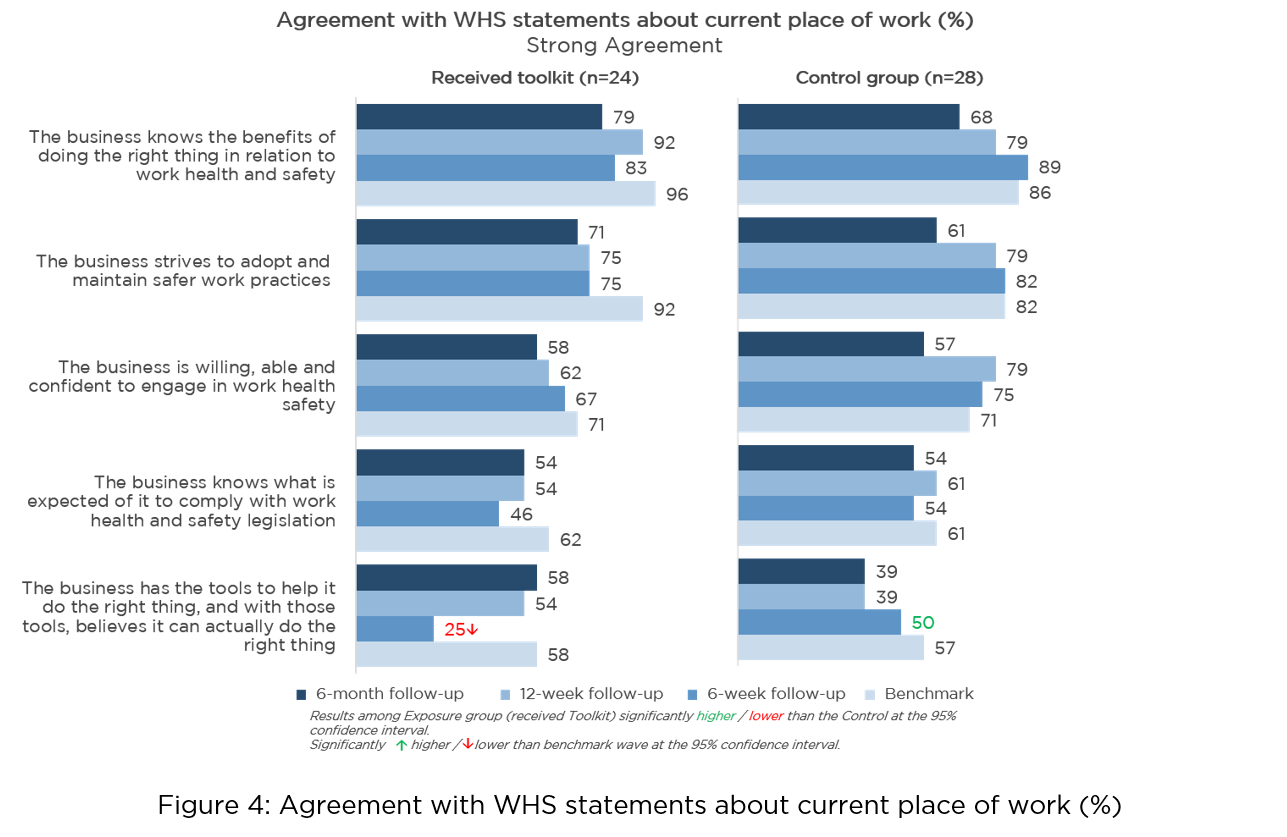
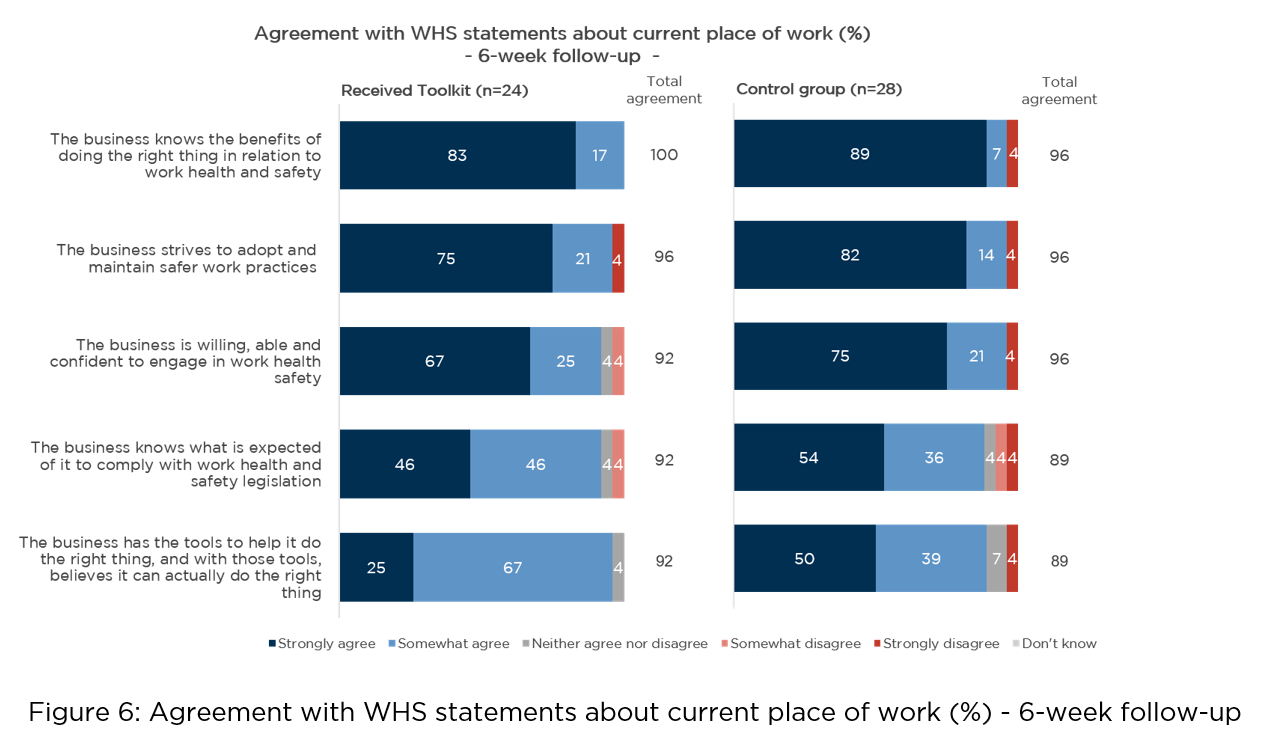
The six-month longitudinal survey found a majority of respondents believes the childcare business they work for knows the benefits of doing the right thing in relation to WHS and strives to adopt and maintain safer practices (86% or above for each) (Fig. 5-8). While not statistically significant on these sample sizes, a strong agreement appeared higher at the six-month follow-up among those who received the Toolkit (79% and 71%, respectively), than among the control (68% and 61%, respectively) (Fig. 4). However, over the duration of the study the levels of agreement appeared to decline overall amongst both groups.
Among both exposure and control groups, there was less certainty around businesses having the confidence and knowledge to meet WHS obligations. While total agreement remained around 9 in 10 or above (Fig. 5-8), just over half stronglyagreed their workplace knows what is expected and is willing, able and confident to engage in WHS at the six-month follow-up (Fig. 8). Positively, most of those who received the Toolkit believed their workplace has the tools to do the right thing, 92% at the six-month follow-up including 58% stronglyagree. While not statistically significant, differences in these sample sizes and agreement among the control group appeared a little lower 71% (39% strongly) (Fig. 7).
The Monash University HaSIC
The Monash University HaSIC is a high-level tool that can be used to assess the potential of workplaces to keep everyone healthy and safe. Table 7 and Figures 9-12 detail the rated performance of each childcare business on a scale of 0-10 (‘very poor’ to ‘excellent’) against this checklist, as rated over a six-month period.
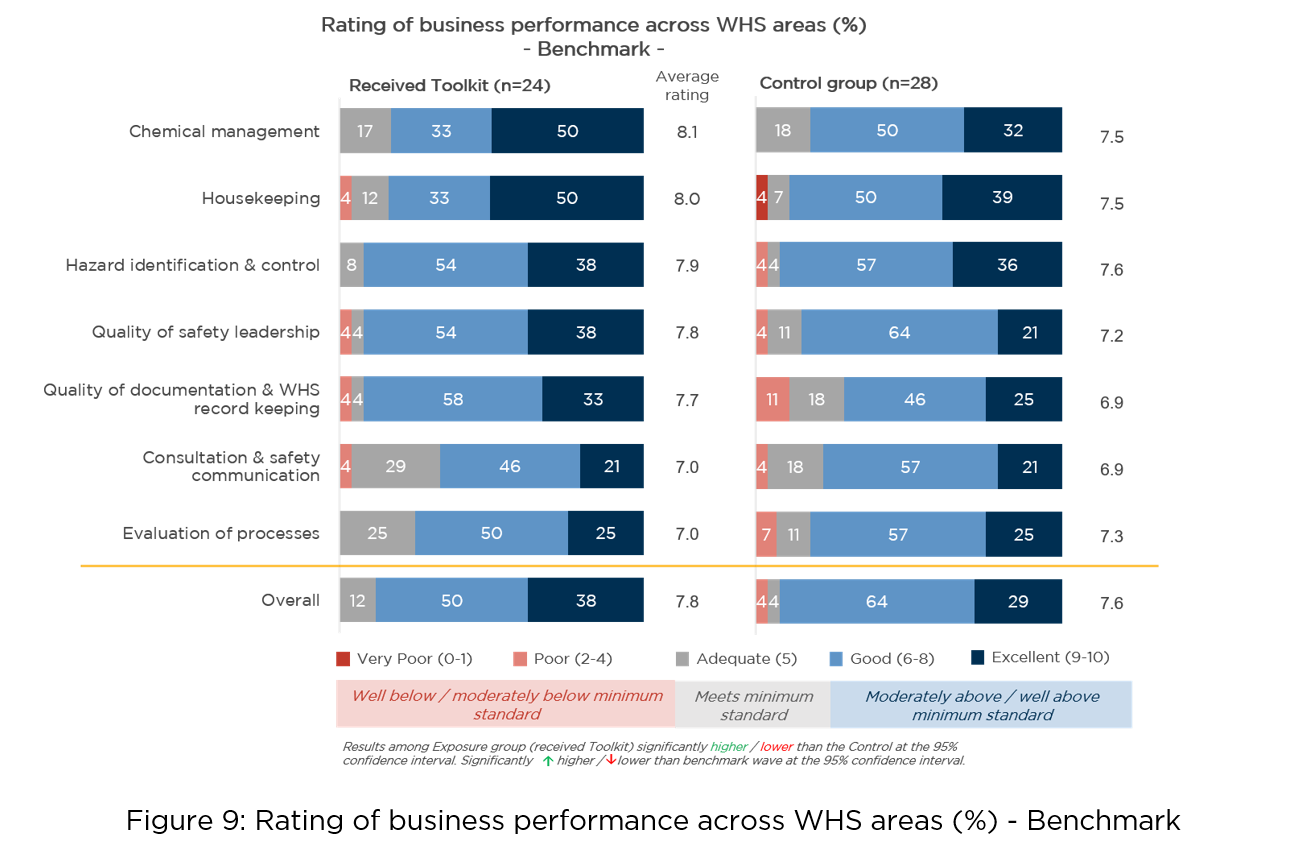
Business performance on WHS was rated by both exposure and control groups as above minimum standard across all HaSIC checklist categories, with an average rating of ‘good’ (6-8 out of 10), suggesting both groups believe their practices to be effective. However, there was still some room to move further up the scale to ‘excellent’ (9-10 out of 10). Although not a statistically significant difference on these sample sizes, average overall ratings on WHS performance appeared a little higher among the exposure (7.9) versus the control group (7.5) at the six-month follow-up (all Table 7).
Performance on ‘chemical management’ was rated the highest in each survey wave among both exposure and control groups. This is in line with qualitative feedback from the follow up interviews stating that centre staff are vigilant with regard to the health and safety because of the children in their care. At the six-month follow-up, half of the exposure group (50%) and four in ten among the control group rated this area as ‘excellent’ (Fig. 12). The area of ‘chemical management’ recorded its strongest result for the exposure group at the six-week follow-up, just after the Toolkits were received (average rating of 8.2 versus 7.7 among the control group) (Table 7).
In contrast, ‘consultation and safety communication’ and ‘evaluation of processes’ were consistently rated lower by both the exposure and control groups, suggesting these are areas where childcare businesses could use more assistance and have room to improve. Phase One of the focus group feedback highlighted the particular challenge in larger businesses/franchises, of maintaining effective consultation and communication about WHS with ‘head office’.
In the area of ‘quality of safety leadership’, there was a statistically significant result at the six-week follow-up, with fewer in the exposure group rating their business performance as ‘good’, compared with the control group. However, this was due to a corresponding (but not statistically significant) difference in ratings as ‘excellent’, which were higher among the exposure group (46%) than the control group (38%). (Fig. 10)
In the exposure group, positive evaluation of their workplace softened from the Benchmark to the six-month follow-up. While not statistically significant, changes across most HaSIC checklist measures were observed. Average ratings and the proportion who rate their workplace’s performance as ‘excellent’ become a little lower among the exposure group. The most notable shifts over the six months were in relation to ‘quality of safety leadership’ (average of 7.8 to 7.2, 38% to 17% excellent), ‘housekeeping’ (8.0 to 7.5, 50% to 33% excellent), and ‘hazard identification and control’ (7.9 to 7.4, 38% to 25% excellent). (Fig. 9 and 12)
It is possible that exposure to the Toolkit highlights shortcomings in these areas that participants were previously unaware of, leading them to rate their workplace’s performance less favourably in follow-up measures after becoming better informed through the Toolkit.
Personal knowledge and understanding of WHS requirements
Almost all survey respondents judged that they understand, ‘very’ or ‘fairly’ well, what they personally need to do in relation to WHS. In each survey wave, the total exposure group (100%) and over 90% among the control felt they understand this well (Fig. 13).
Although not a statistically significant increase on this sample size, confidence in their understanding of WHS obligations appeared to strengthen briefly after initial receipt of the Toolkit. At the 6-week follow up, a majority of the exposure group (58%) felt they understood their responsibilities ‘very well’, versus only 32% among the control (Fig. 13). This compares with 42% and 46% for the exposure group who felt they understood their responsibilities ‘very well’ in subsequent 12-week and six-month follow-ups.
This suggests that, while the Toolkit is a positive move forward, there is also a need for ongoing engagement with the NSW small business workforce in relation to their understanding of good WHS practice and their own obligations. Qualitative feedback from user follow-up interviews found that some looked through the Toolkit document when it was first received before filing it away for possible future needs.
A majority of respondents in each survey wave felt confident that they could identify WHS gaps within their workplace: at least three-quarters of the exposure group and over 80% among the control group. Further, at the final six-month follow-up, over half of each group strongly agreed they could do so (54% of the exposure group, 57% of the control) (Fig. 14). This represents a high level of confidence among those who have not accessed the Toolkit. It is unclear how much of this confidence is due to other information sources or knowledge that they may possess, and how much is due to ignorance (i.e. ‘you don’t know what you don’t know’).
Staying informed about WHS requirements
At both the 12-week and six-month follow-up surveys, 9 in 10 who received the Toolkit found it easy to locate WHS information (92% and 88% respectively) – almost half found it ‘very easy’ (46% each wave). Although not a statistically significant increase in this sample size, these results compare favourably with a lower pre-Toolkit baseline of 75% who found it easy.
On a further positive note, exposure to the Toolkit resulted in significantly higher results than among the control group. Fewer without access to the Toolkit found WHS information easy to locate at both the 12 week (71%) and six-month follow-ups (64%). (Fig. 15)
Internet searches were the ‘go-to’ source for WHS information, highlighting that clear online access to the Toolkit is essential. Three-quarters of respondents at the final 6-month measure claimed they would do an internet search to find more information about WHS (73%), while about half would go directly to a Government (54%) or industry body (52%) and fewer to other sources such as insurance providers or consultants (Fig. 16).
Indeed, at the six-month follow-up, four of the seven control group respondents, who were aware of the Toolkit, heard about it from the SafeWork NSW website (n=2), or emails from SafeWork NSW (n=1) or an industry body (n=1). The balance (n=3) were unsure of the source.
Among the small exposure sample (n=24), half confirmed they had received the Toolkit, including 33% who had used the Toolkit (i.e. read or looked through it, acted upon information in it, shared it with colleagues) and 17% who had not yet used it (Table 8). All users rated the Toolkit ‘very’ (n=3) or ‘fairly’ (n=5) useful.
Phase Three Qualitative Follow-up:
User feedback on the revised Toolkit format and content
In follow-up interviews with a sample of Toolkit recipients (n=3 users, n=1 recipient who had not used it), the Toolkit was viewed as visually appealing, well laid out and easy to read. Users had felt enticed to browse through, upon receiving it, and some had put up the accompanying ‘If you get injured at work’ poster in a prominent location such as a staff room. It was also well-received when shared with colleagues.
The Toolkit was considered a good overview of WHS, easy to understand and as providing a structured approach to WHS. It was seen as particularly useful for someone new to WHS in childcare, or for smaller centres needing to put WHS practices in place without the expertise and support of a larger organisation/franchise.
“I actually think it’s a good tool and checklist for people that don’t have a level of management to support them. In a very small family-based company you don’t have the systems in place.” (Childcare Centre, Phase 3 user feedback)
Recipients viewed the Toolkit as a companion resource to other industry-specific information and legislation. In line with the earlier focus groups, they typically supplement general government information with industry-specific sources such as relevant legislation, national and state government websites (including SafeWork NSW), information from industry peak bodies, advice from HR and legal professionals, and industry suppliers information (e.g. of chemicals, materials, tools and equipment). There was some feedback that the Toolkit provided very general information, and this was cited as a reason some recipients had not engaged with it much (or at all).
Lack of time and perceived need were other barriers to initial/ongoing engagement with the Toolkit. Recipients already comfortable with their current WHS knowledge and their business’ practices, did not view the Toolkit as something they needed to immediately review in detail. Instead, they had plans to use the Toolkit at a more convenient time in the calendar year to refresh their policies and for new WHS ideas.
However, others had used the Toolkit to help assess current practices and update policies, and all recipients expected it to be a useful ad hoc reference in the case of a workplace incident, safety audit, or for speaking to colleagues about WHS. Even those who viewed their current WHS policies and practices as adequate noted that the Toolkit would serve as a future prompt and resource for reviewing and updating their processes.
The checklist and action plans were particularly well-received, and recipients had, or expected to get much use out of these resources, noting that these are tools that other resources do not offer. The checklist’s use of icons and colours was appealing, and its format was easy to use to determine if any action on WHS was required. It had prompted some users to consider the adequacy of their mental health policy and staff inductions.
The action plan format was also seen as easy to use, and a useful way to document issues and suggestions, which can be forgotten by the time a staff meeting occurs. Some users had planned to distribute the action plan to workers as a tool to reinforce that they all have a responsibility for WHS and to encourage them to think about WHS all the time, rather than just when an incident occurs. They noted that, in practice, WHS issues with obvious dangers tended to be taken more seriously by staff than those with less obvious WHS dangers.
Some information sections of the Toolkit felt more relevant, practical and easier to apply to childcare workplaces than others. ‘Managing risk’ allows businesses to easily identify risks and how to manage them, and users acknowledged the benefits this information could provide. Further, reporting of risks is an area where users felt staff often lacked effort, making this section highly relevant and useful.
‘Worker capability’ and ‘safe working environment’ sections were seen as providing clear and sensible information and the ‘emergency plan’ section had already been used by some to review current practices.
With such a focus on the children in their care, users recognised their own employee WHS as an area they could improve on, with mental health and stress being key areas. These areas currently receive a small mention under ‘safe working environment’, and it was felt that these could be expanded upon in future resources. There was also an interest in industry-specific hazards, such as lifting children, stress and pregnancy in childcare.
The tangible benefits of the ‘your commitment’ and ‘consultation’ sections were less obvious to users.
While both hard copy and electronic Toolkit formats were viewed as useful, businesses typically consult online resources as ease of access allows quick retrieval of information. Suggested enhancements for the Toolkit’s electronic/online version included an interactive checklist and action plans, and active hyperlinks in the information sections linking to relevant resources, e.g. related legislation, useful government or industry websites, and additional materials such as induction modules, factsheets and videos.
Some recipients highlighted the limitations of the Google search, noting mixed success in finding the information they sought online, often ending up on interstate websites. It is therefore important to provide clear and obvious pathways for those doing a general WHS internet search to ensure they are directed to the online Toolkit materials or the contact pathways to receive a hard copy.
Promoting the Toolkit
Industry bodies were viewed as trusted by and best connected to workers to promote this Toolkit, with workers likely to read the information received from these organisations. It was thought industry bodies could assist by highlighting the relevance and key take-outs from general resources, such as the Toolkit, to their specific industries. Businesspeople are alert to regular updates from industry bodies, summarising relevant changes or trends in WHS and other areas of regulation.
It was suggested the Toolkit could be promoted through regular industry newsletters, emails, social media or at meetings and conferences. For the childcare sector, this is organisations like the Australian Children’s Education and Care Quality Authority (ACECQA) and Australian Childcare Alliance. In other industries, this could include via the Building Code of Australia, NSW Farmers, and Cotton Australia.
Government organisations were also viewed as a credible information source, with SafeWork NSW Staff (also referred to as Workcover) being trusted spokespersons on WHS issues, familiar to businesspeople via their presence at industry events and information days.
Limitations
Qualitative research is exploratory in nature and the findings from Phase One and Three focus groups and interviews are indicative only and not necessarily fully representative of the target populations, which only quantitative research can confirm.
Final sample sizes for the quantitative Phase Two research among NSW childcare centres were small, 24 in the Toolkit exposure group and 28 in the control, making it more difficult to distinguish between a real effect and random variation. Large margins of error around the survey results should be taken into account in interpreting these longitudinal results within and between the two groups.
Concluding remarks and recommendations
Qualitative feedback during pre-testing and follow-up interviews highlighted the potential of the Toolkit as both a strong starting point for businesses needing to set up their WHS regime, and an audit and refinement tool for those with policies and processes already in place. The Toolkit’s clear, simple framework and explanations could be used to talk to management and staff about WHS regulations and their responsibilities, and to develop or enhance training resources. The Checklist was viewed as useful for regular ‘check-ins’ to identify gaps in knowledge and practice. The Toolkit’s separate chapters were deemed easy to use and valuable for urgent or ad hoc information needs, e.g. dealing with workplace incidents or workers’ compensation cases. The final action plan provides a useful tool for management and staff to formalise suggestions and improvements by helping to define actions, resources and timeframes that can be monitored. More broadly, it was thought that the use of the action plan could also encourage better staff habits in thinking about, recording, and acting on WHS issues.
Quantitative survey results provided some indications that the Toolkit contributes to making it easier for small businesses to do WHS. Those who received the Toolkit were significantly more likely to feel WHS information is easy to find than those without the Toolkit. In other encouraging, but not statistically significant, results, more Toolkit recipients felt their workplace had the tools to help it do the right thing, and their understanding of their personal WHS obligations improved in the six weeks after receiving the Toolkit. However, with few statistically significant differences in results over time or between the small exposure and control samples, it is difficult to form conclusions about the true impact of the Toolkit on attitudes and behaviours. A large majority of both the exposure and control groups rated the attitudes and actions of their workplace positively, agreeing the business knew its WHS obligations and the benefits of doing the right thing, had the confidence to engage in WHS and strives toward safer practices. Further, both groups rated their workplace as performing moderately above the minimum standard, on average, across all HaSIC categories.
Survey results supported qualitative feedback on the importance of providing an online version of the Toolkit and promoting the Toolkit through other Government and industry-specific channels. Most survey respondents indicated that they would undertake an internet search if they needed more information on WHS, highlighting the need for an online Toolkit that is picked up through simple search terms and easily accessible links. With half of the survey respondents sourcing WHS information from Government and industry bodies, there are opportunities to provide access to, or promote the Toolkit via these channels. These views were in line with the qualitative feedback, which also supported enhancing the Toolkit’s online features and functionality.
In response to this audience feedback and indicative success of the Toolkit, consideration should be given to the following recommendations to:
- Raise awareness of the Toolkit by promoting it to small business through newsletters, social media, events and specific industry channels.
- Facilitate wider access to the Toolkit by developing an online version, ideally with enhanced functionality, such as an interactive checklist and action plan, automatic notifications/reminders, and active hyperlinks in the information sections linking to relevant resources, legislation and external websites.
- Encourage the wider use of the Toolkit by promoting its value as both an information source for businesses establishing their WHS regime, and an internal audit tool for businesses with established WHS systems to regularly check and refine their practices.
- Further support best-practice WHS and compliance by developing/promoting supplementary resources such as induction modules, factsheets and videos, and linking these to an online Toolkit. Consideration should be given to preparing or including links to industry-specific material.
- Provide a feedback mechanism for users to suggest new topics, emerging issues or extra resources (e.g. forms, lists, exercises) for inclusion in future updates to the Toolkit.
Acknowledgements
The contribution and assistance of the following persons in producing this report are gratefully acknowledged:
- Jayde Grisdale and Cassandra Marks, JWS Research, for focus groups and survey analysis.
- Christine Lindsay and SafeWork NSW for feedback on the report.
- Participants in focus groups, surveys and follow up interviews.
All research was conducted in compliance with AS-ISO 20252.
References
SIRA. (2017) Making it easier: Small business strategy 2017-2019. p.3. Retrieved from https://www.sira.nsw.gov.au/resources-library/workers-compensation-resources/publications/workers-and-claims/making-it-easier-whs-and-workers-compensation-small-business-strategy-2017-2019
Appendices
A: Phase One Focus Group Discussion Guide
Introductions: 10 minutes
To start with…
- Thank and welcome
- Moderator introduction, representing independent research agency and so objective – no vested interest in the material
- Explain group process, no right or wrong answers, important to hear from everyone
- Confidentiality
- Explain recording, people watching, one-way mirror
- Mobiles off, please!
- Confirm the length of the group – 1.45 hours
Round of introductions (brief):
- First name, where you’re from, what is the business you work at, your role in the business and the size of the business.
Work Health and Safety Discussion: 10 minutes
We are going to start by talking about work health and safety.
- When I say work health and safety, what does that mean to you?
- First things to mind?
- How would you define it?
- If not mentioned, explain they are regulations that reduce work-related fatalities, serious injuries and illness that make it easier to do business safely.
- How does work health and safety relate to your business?
- Is it important for your business?
- Where would you go to find information about work health and safety for your business?
- How easy is it to find information?
- Ascertain avenues that people currently use to find out information on these topics.
- What about keeping up with work health and safety regulations and information – is this something you do?
- If so, is it an easy process?
- How do you go about it?
- Explore fully
- How could work health and safety information be made easier for your business to find and understand?
Overall Reactions to the Toolkit: 20 minutes
Today we are going to look at a kit that has been developed to make work health and safety easier for businesses.
In front of each of you is a copy of the kit, and a pen and some paper if you need it.
EXPLAIN: Please keep in mind these materials are still a work in progress and not finalised.
I am now going to give you 5 minutes to take a quick look around the kit, without talking or discussing it. Write down any questions, or any thoughts and comments you have.
Let’s talk about your impressions…
- What were your first impressions of the kit?
- What words would you use to describe it?
- What do you like about it?
- What do you dislike about it?
- What stood out to you about it?
- How do you feel about the cover? How would you describe it?
- The contents page: Can you understand where to go for what you’re looking for?
- And the introduction? Have a quick look at this if you haven’t already – impressions?
- Who do you think this kit is aimed at? Is it for a business like yours? Explore fully
- What do you see as the intention or purpose of the kit? What are the designers trying to achieve by getting this out to businesses?
I’m interested in understanding whether you feel you would use the kit, and in what scenarios…
- What would happen if this arrived on your desk? What would you do (with it)?
- Would you be motivated to pick it up? Explore reasons why/why not
- Would there be certain scenarios that might make you more likely to pick it up?
What about the ‘instructions’ page…
- Thoughts? Impressions?
- Does it make sense to you?
- Is it clear what it is asking you to do?
And the ‘checklist’…
- Thoughts? Impressions?
- Does it make sense to you?
- Is it clear what it is asking you to do?
Is there anything you see requiring improvement? We’ll talk about it again later in the group when we’ve had a more detailed look through, but any thoughts now are welcome.
Using the Toolkit – Starting with the Checklist: 15 minutes
This kit has been designed to be completed in a number of steps.
I would like you to have a look and see what you feel is the first step you would take.
Don’t complete anything yet just have a look around to see where you would start.
Participants should start at the instructions and checklist, but not fill it out yet – we want to understand whether people would intuitively fill this out first, and where they would go from there.
What do you think is the first step you would take?
- Why?
- What difficulties did you have?
- What could be done better?
I am now going to give you a moment to fill out the checklist. Please don’t move past the checklist until I tell you.
- What do you think of the general look and feel of the checklist?
- What about the imagery/icons?
- And the headings? Are they relevant to your business? Is there anything missing?
- Was it easy to fill out?
- Was the language appropriate/ are there any terms or questions that don’t make sense?
- Is there any language that could be changed to simplify it?
NOTE: listen out for mentions of the glossary section.
- Who do you think this checklist is aimed at specifically?
- Can you relate to this? Does it make sense for your business?
Point to the glossary on page 38 to 40 of the tool kit…
- Did you realise there was a glossary in the Toolkit?
- Do you think it is a useful inclusion? Is it necessary?
- Would you think to look for it? If not, where could it be better placed that would assist you?
Overall, can you suggest any improvements that could be made to the checklist?
Once you’ve completed the checklist, if it directs you to any specific section, please head to that section and take a quick look. I’m interested to see if once you get there you know what to do, what to look for, where to go next…
- Were you able to find what to do next? Was it easy to find?
- What difficulties did you have? What could be done better?
Consultation and Communication Section: 10 minutes
I would now like you to read through the Consultation and Communication section of the Toolkit booklet.
Let’s talk about your overall impressions…
- What were your first impressions of this section?
- How would you describe the content of the section?
- What stood out to you about it?
- Is it easy to understand? Does it make sense?
- Would you say it is relevant to you and your business?
- In what way is/isn’t it?
- How would describe the tone of it? The word choice?
- What do you think of the layout and the look and feel?
I’m interested in the main message you take out of this section…
- What would you say are the key messages from your perspective?
- What might you do as a result of reading this?
- Does it motivate you to do anything?
- Would you take any action?
Managing Risks Section: 10 minutes
I would now like you to read through the Managing Risks section of the Toolkit booklet.
Let’s talk about your overall impressions…
- What were your first impressions of this section?
- How would you describe the content of the section?
- What stood out to you about it?
- Is it easy to understand? Does it make sense?
- Would you say it is relevant to you and your business?
- In what way is/isn’t it?
- How would describe the tone of it? The word choice?
- What do you think of the layout and the look and feel?
I’m interested in the main message you take out of this section…
- What would you say are the key messages from your perspective?
- What might you do as a result of reading this?
- Does it motivate you to do anything?
- Would you take any action?
Extra Section: 5 minutes
Each group will be allocated one additional section to read and discuss.
This section will be one of Management Commitment, Reporting, Worker Capability, Safe Working Environment or Workers Compensation and Recovery at Work. One group will also be allocated the Forms/Templates section.
I would now like you to read through the (allocated section) of the Toolkit booklet.
Let’s talk about your overall impressions…
- What were your first impressions of this section?
- How would you describe the content of the section?
- What stood out to you about it?
- Is it easy to understand? Does it make sense?
- Would you say it is relevant to you and your business?
- In what way is/isn’t it?
- How would describe the tone of it? The word choice?
- What do you think of the layout and the look and feel?
I’m interested in the main message you take out of this section…
- What would you say are the key messages from your perspective?
- What might you do as a result of reading this?
- Does it motivate you to do anything?
- Would you take any action?
TEMPLATE GROUP ONLY
I would now like you to have a look through the Templates on pages 29 to 34…
- What were your first impressions of these forms?
- What stands out to you about them?
- Strengths? Weaknesses?
- Are they easy to understand? Do they make sense?
- Would you say they are relevant to you and your business?
- In what way are they/aren’t they?
- Do you think you might use these templates? Which ones in particular?
- What do you think of the layouts?
- Is there anything missing?
- How would you use the templates in practice?
- Would you photocopy them? Pull them out? Go to the website to download a digital version?
Action Plan: 10 minutes
The next thing we are going to do is have a look at the Action Plan section of the Toolkit. You’ll find this from page 26 to 28.
Is it clear when or why you would go to this section?
At what point are you directed to this section?
Are there instructions directing you there?
- Would you have a reason to look for this section at any point?
- Is it easy to find?
- Looking at the headings, does everything look to be covered?
- Is there anything missing?
- How could this be improved?
Can you anticipate actually using this action plan in real life?
- In what way?
- If yes, how would you use it in practice?
- Would you photocopy it?
- Pull it out?
- Go to the website to download a digital version?
Wrap Up: 10 minutes
Thank you for all your input this evening. We’ve covered a lot and you’ve provided some very interesting insight for us.
Just to finish up, I’d like to understand your thoughts in summary.
- Overall, how would you describe the Toolkit?
- Would you say it is simple and easy to understand?
- Do you feel the steps are clear, and you always know what to do next?
- Can you see your business using this in real life? Explore
- For you and your business, what are the most and least useful parts for you in terms of aiding compliance with WHS regulations?
- Overall, do you think the Toolkit will be an effective way of helping businesses become safer and more productive?
- Overall, do you think it helps make it easier to understand WHS regulations?
- Overall, do you think it helps make it easier for businesses to comply with WHS regulations?
Thank, close and provide an incentive.
B: Phase One Stakeholder Interview Guide
INTRODUCTION
To start with… Thank you for participating
[Interviewer introduction, representing independent research agency and so objective – no vested interest in the material. Explain the interview process, no right or wrong answers, confidentiality, 30 minutes duration, explain recording and note-taking.]
Ask participants to introduce themselves - Name? Organisation representing? Tenure? Role within the organisation?
OVERALL REACTIONS TO THE TOOLKIT
As you know, we emailed you a copy of the Work Health and Safety Toolkit that is the focus of today’s discussion. Hopefully, you’ve had a chance to read through and digest it.
I’m really interested in your impressions of this Toolkit… What were your first impressions?
- What words would you use to describe it?
- What do you like about it?
- What do you dislike about it?
- What stood out to you about it?
- How do you feel about the cover? How would you describe it?
- The contents page? Does it make sense? Is it clear to you?
- And the introduction? Have a quick look at this if you haven’t already – impressions?
Who do you think this kit is aimed at? [Explore fully]
- What do you see as the intention or purpose of the kit?
- What are the designers trying to achieve by getting this out to businesses?
- How do you feel this will be received by small businesses? Do you think they would see it as useful?
- What do you think will happen when this arrives on the desks of small business owners or managers?
Do you think they would be motivated to pick it up? [Explore reasons why/why not]
- What about the ‘instructions’ page…Thoughts? Impressions?
- Does it make sense to you?
- Is it clear what it is asking businesses to do?
- And the ‘checklist’…Thoughts? Impressions?
- Does it make sense to you?
- Is it clear what it is asking businesses to do?
- Is there anything you see requiring improvement?
USING THE TOOLKIT – STARTING WITH THE CHECKLIST
This kit has been designed for small businesses to complete in a number of steps. Based on what you have read and seen of the Toolkit, is it clear what steps businesses might take?
- Do you think it is spelt out clearly for them? [Explore fully]
- Let’s take a closer look at the checklist… What do you think of the general look and feel of it?
- What about the imagery/icons?
- And the headings? Are they relevant to small businesses? Is there anything missing?
- Does it appear easy to fill out?
- Is there any language that could be changed to simplify it?
- Overall can you suggest any improvements that could be made to the checklist?
REACTIONS TO VARIOUS SECTIONS WITHIN THE TOOLKIT
When you were having a browse through the Toolkit, or if you’d like to do so now, I’d love to hear any feedback you have about the sections found between pages 4- 23.
[Reactions to sections – explore reactions as they raise questions/comments/thoughts: Management Commitment; Consultation and Communication; Managing Risks; Reporting; Worker Capability; Safe Working Environment; Workers Compensation and Recovery at Work; also explore reactions to the forms/templates which are found on pages 29-34.]
- What were your first impressions of these forms?
- What stands out to you about them?
- Strengths? Weaknesses?
- Are they easy to understand? Do they make sense?
- What do you think of the layouts?
- Would you say they are relevant to small business? In what way are they/aren’t they?
- Is there anything missing?
ACTION PLAN
I’d now like you to have a look at the Action Plan section of the Toolkit. You’ll find this on pages 26 to 28. Is it clear when or why small businesses would go to this section?
- At what point are they directed to this section?
- Are there instructions directing them there?
- Do you think it is easy to find?
- Looking at the headings, does everything look to be covered?
- Is there anything missing?
- How could this be improved?
- Can you anticipate small businesses actually using this action plan in real life?
WRAP UP
Just to finish up, I’d like to understand your thoughts in summary. Overall, how would you describe the Toolkit?
- Would you say it is simple and easy to understand?
- Do you feel the steps are clear, and that small business would always know what to do next?
- Can you see small businesses using this in real life? [Explore]
- Overall, do you think the Toolkit will be an effective way of helping businesses become safer and more productive?
- Overall, do you think it helps make it easier for businesses to understand WHS regulations?
- Overall, do you think it helps make it easier for businesses to comply with WHS regulations?
[Thank, close and provide incentive]
C: Phase Two Longitudinal Survey Questionnaire
INTRODUCTION
Thank you for agreeing to participate in this survey. It should only take 10 minutes to complete / Waves 2 to 4: Thank you for agreeing to participate in this follow-up survey. It should only take 5 minutes to complete
Privacy and confidentiality
This research is being conducted in accordance with the relevant privacy laws, including the Market and Social Research Privacy Principles, as well as the industry’s code of professional behaviour.
Your participation is completely confidential. That means that the Centre for Work Health and Safety will not know the names, business or any identifying information about who has responded to this survey.
Questions?
If you have any problems during the survey, please email [email protected]
Using the survey
Please do not use the refresh, back or forward buttons on your browser during the survey, and do not use your keyboard except where you are asked to type in a response. Instead, please just use your mouse and any buttons within the survey itself.
The survey must be completed in one sitting since you will not be able to access it at a later time.
Please maximise this window and click on the ‘NEXT’ button to begin this survey.
We hope you enjoy completing this survey and thank you for your time!
Screening Questions
(WAVES 2 to 4)
D4a | A few weeks ago, someone from your organisation completed a survey of WHS in childcare businesses for the Centre for Work Health and Safety. Please confirm if it was you personally who completed this survey, or someone else in your organisation. | |
I completed the previous survey | 1 | |
Someone else completed the previous survey | 2 | |
First a few questions about the business and your role there
ASK ALL (WAVE 1)
S1 | What is the size of the company you work in across all sites/centres? A best estimate is fine if you are unsure. | |
I am a sole trader | 1 | |
1 to 4 employees | 2 | |
5 to 19 employees | 3 | |
20 to 199 employees | 4 | |
Over 200 employees | 5 | |
ASK NOT SOLE TRADER S1 ≠1 (WAVE 1)
S2 | How many employees (fulltime equivalent) work at the site/centre you mainly work at? A best estimate is fine if you are unsure. | |
I am a sole trader | 1 | |
1 to 4 employees | 2 | |
5 to 10 employees | 3 | |
11-15 employees | 4 | |
16-19 employees | 5 | |
20 or more employees | TERMINATE WITH THANKS | |
DEMOGRAPHIC QUESTIONS
ASK ALL (WAVE 1)
D1 | What services are offered at the site/centre you mainly work at? Select all that apply RANDOMISE 1 to 6 | |
Long day care | 1 | |
Occasional care | 2 | |
Family day care | 3 | |
In home care | 4 | |
Before school care | 5 | |
After school care | 6 | |
Other (please specify) | 7 | |
ASK ALL (WAVE 1)
D2 | Where is the site/centre you mainly work in located? | |
Sydney | 1 | |
Rest of New South Wales | 2 | |
Rest of Australia | CLOSE | |
Not currently living in Australia | CLOSE | |
ASK ALL (WAVE 1)
D3 | How would you best describe the area of the site/centre you mainly work in? | |
Inner metropolitan | 1 | |
Outer metropolitan | 2 | |
Regional centre | 3 | |
Rural | 4 | |
Remote | 5 | |
ASK ALL (WAVE 1 and new completer WAVE 2 to 4)
D4 | And within that site/centre, which of the following best describes your current role? RANDOMISE 1 to 6 MULTIPLE RESPONSE ALLOWED | |
Administration/ office duties | 1 | |
Assistant | 2 | |
Educator | 3 | |
Room leader | 4 | |
Centre Manager / Co-ordinator | 5 | |
Owner | 6 | |
Other (please specify) | 7 | |
ASK ALL (WAVE 1 and new completer WAVE 2 to 4)
D5a | Do you perform duties related to work health and safety? | |
Yes | 1 | |
No | 2 | |
ASK NOT SOLE TRADER S1 ≠1or S2≠1 (WAVE 1 and new completer WAVE 2 to 4)
D5b | Are you responsible for the direct supervision/management of other staff members? | |
Yes / have staff management responsibilities | 1 | |
No | 2 | |
ASK ALL (WAVE 1 and new completer WAVE 2 to 4)
D6 | Approximately how long have you been in your current role? | |
Less than 12 months | 1 | |
1-2 years | 2 | |
3-5 years | 3 | |
6-10 years | 4 | |
Longer than 10 years | 5 | |
Can’t say | 6 | |
MAIN QUESTIONS
Now for some questions about work health and safety.
Please be assured that your responses are completely confidential and will be used only for the purpose of this research project.
ASK ALL
Q1 | To what extent do you agree or disagree with the following statements about the centre/site where you currently work? It’s okay if you’re not sure – it’s just your own opinion and impressions we’re interested in. | ||||||
RANDOMISE CODES A TO F | Strongly agree | Somewhat agree | Neither agree nor disagree | Somewhat disagree | Strongly disagree | Can’t say | |
A | The business strives to adopt and maintain safer work practices | 1 | 2 | 3 | 4 | 5 | 6 |
B | The business is willing, able and confident to engage in work health safety | 1 | 2 | 3 | 4 | 5 | 6 |
C | The business knows what is expected of it to comply with work health and safety legislation | 1 | 2 | 3 | 4 | 5 | 6 |
D | The business knows the benefits of doing the right thing in relation to work health and safety | 1 | 2 | 3 | 4 | 5 | 6 |
E | I can identify areas of the business that need improvement in relation to work health and safety | 1 | 2 | 3 | 4 | 5 | 6 |
F | The business has the tools to help it do the right thing, and with those tools, believes it can actually do the right thing | 1 | 2 | 3 | 4 | 5 | 6 |
SEPARATE INTRO SCREEN
The next few questions ask you to rate some aspects of work health and safety in the business you currently work in.
Again, it is your own opinion and impressions we are interested in.
Please be assured that your responses are completely confidential and will be used only for the purpose of this research project.
ASK ALL
Q2 | In your opinion, how well does this business perform in the area of Housekeeping? Please rate it on a scale from 0 to 10 (‘very poor’ to ‘excellent’) using the headings and dot points above to help you decide. | |||||||||||
Very poor (well below minimum standard) | Poor (moderately below minimum standard) | Adequate (meets minimum standard) | Good (moderately above minimum standard) | Excellent (well above minimum standard) | ||||||||
Housekeeping |
| of the site.
| ||||||||||
0 | 1 | 2 | 3 | 4 | 5 | 6 | 7 | 8 | 9 | 10 | ||
ASK ALL
Q3 | In your opinion, how well does this business perform in the area of Evaluation of Processes? Please rate it on a scale from 0 to 10 (‘very poor’ to ‘excellent’) using the headings and dot points above to help you decide. | |||||||||||
Very poor (well below minimum standard) | Poor (moderately below minimum standard) | Adequate (meets minimum standard) | Good (moderately above minimum standard) | Excellent (well above minimum standard) | ||||||||
Evaluation of Processes |
| updated.
are task specific.
of plant and equipment.
| ||||||||||
0 | 1 | 2 | 3 | 4 | 5 | 6 | 7 | 8 | 9 | 10 | ||
ASK ALL
Q4 | In your opinion, how well does this business perform in the area of Hazard Identification and Control? Please rate it on a scale from 0 to 10 (‘very poor’ to ‘excellent’) using the headings and dot points above to help you decide. | |||||||||||
Very poor (well below minimum standard) | Poor (moderately below minimum standard) | Adequate (meets minimum standard) | Good (moderately above minimum standard) | Excellent (well above minimum standard) | ||||||||
Hazard identification and control |
| |||||||||||
0 | 1 | 2 | 3 | 4 | 5 | 6 | 7 | 8 | 9 | 10 | ||
ASK ALL
Q5 | In your opinion, how well does this business perform in the area of Quality of Safety Leadership? Please rate it on a scale from 0 to 10 (‘very poor’ to ‘excellent’) using the headings and dot points above to help you decide. | |||||||||||
Very poor (well below minimum standard) | Poor (moderately below minimum standard) | Adequate (meets minimum standard) | Good (moderately above minimum standard) | Excellent (well above minimum standard) | ||||||||
Quality of safety leadership |
| |||||||||||
0 | 1 | 2 | 3 | 4 | 5 | 6 | 7 | 8 | 9 | 10 | ||
ASK ALL
Q6 | In your opinion, how well does this business perform in the area of Quality of Documentation & WHS Record Keeping? Please rate it on a scale from 0 to 10 (‘very poor’ to ‘excellent’) using the headings and dot points above to help you decide. | |||||||||||
Very poor (well below minimum standard) | Poor (moderately below minimum standard) | Adequate (meets minimum standard) | Good (moderately above minimum standard) | Excellent (well above minimum standard) | ||||||||
Quality of Documentation & WHS Record Keeping |
| |||||||||||
0 | 1 | 2 | 3 | 4 | 5 | 6 | 7 | 8 | 9 | 10 | ||
ASK ALL
Q7 | In your opinion, how well does this business perform in the area of Consultation and Safety Communication? Please rate it on a scale from 0 to 10 (‘very poor’ to ‘excellent’) using the headings and dot points above to help you decide. | |||||||||||
Very poor (well below minimum standard) | Poor (moderately below minimum standard) | Adequate (meets minimum standard) | Good (moderately above minimum standard) | Excellent (well above minimum standard) | ||||||||
Consultation and Safety Communication |
| |||||||||||
0 | 1 | 2 | 3 | 4 | 5 | 6 | 7 | 8 | 9 | 10 | ||
ASK ALL
Q8 | In your opinion, how well does this business perform in the area of Chemical Management? Please rate it on a scale from 0 to 10 (‘very poor’ to ‘excellent’) using the headings and dot points above to help you decide. | |||||||||||
Very poor (well below minimum standard) | Poor (moderately below minimum standard) | Adequate (meets minimum standard) | Good (moderately above minimum standard) | Excellent (well above minimum standard) | ||||||||
Chemical Management |
| |||||||||||
0 | 1 | 2 | 3 | 4 | 5 | 6 | 7 | 8 | 9 | 10 | ||
ASK ALL
Q9 | Overall, how would you rate the Work Health and Safety of your workplace? | |||||||||||
Very poor (well below minimum standard) | Poor (moderately below minimum standard) | Adequate (meets minimum standard) | Good (moderately above minimum standard) | Excellent (well above minimum standard) | ||||||||
0 | 1 | 2 | 3 | 4 | 5 | 6 | 7 | 8 | 9 | 10 | ||
ASK ALL
Q10 | How easy is it to find information on Work Health and Safety? | |
Very easy | 1 | |
Somewhat easy | 2 | |
Neither easy nor difficult | 3 | |
Somewhat difficult | 4 | |
Very difficult | 5 | |
Can’t say | 6 | |
ASK ALL
Q11 | Where would you go to find more information about Work Health and Safety? Please select all that apply. RANDOMISE CODES 1-6 | |
Internet search | 1 | |
Insurance provider | 2 | |
A friend | 3 | |
Government body | 4 | |
Consultant | 5 | |
An industry body | 6 | |
Can’t say | 7 | |
ASK ALL
Q12 | How well do you understand what you personally need to do in relation to Work Health and Safety? | |
Very well | 1 | |
Fairly well | 2 | |
Not very well | 3 | |
Not at all well | 4 | |
Can’t say | 5 | |
ASK CONTROL GROUP (WAVE 4)
Q13a | [DISPLAY COVER JPG] In October 2018, SafeWork NSW launched an Easy to do WHS Toolkit to make it easier for small businesses to comply with their work health and safety (WHS) obligations. Are you aware of this Toolkit? Please indicate which of these describe you. SINGLE RESPONSE | |
You were not aware of this Toolkit before today | 1 | |
You were aware of it but have not received / downloaded a copy | 2 | |
You have received / downloaded the Toolkit but not used it yet | 3 | |
You have used this Toolkit (e.g. read / looked through it, acted on information in it, shared it with colleagues) | 4 | |
Can’t say | 5 | |
ASK CONTROL GROUP (WAVE 4)
Q13b | How did you hear about the Easy to do WHS Toolkit? Select all that apply. CODE 1 to 5 ARE MULTIPLE RESPONSE | |
Social Media | 1 | |
Centre for WHS email | 2 | |
SafeWork Website | 3 | |
SafeWork Wrap | 4 | |
SafeWork Email | 5 | |
SIRA Newsletter | 6 | |
Industry Email e.g. NSW Business Chambers | 7 | |
Get Healthy at Work | 8 | |
Industry event e.g. HIA tradie night | 9 | |
Services NSW | 10 | |
Some other way (please specify) | 11 | |
Can’t say | 12 | |
ASK TEST GROUP (WAVE 4)
Q14a | [DISPLAY COVER JPG] About 6 months ago, we sent you / your workplace an information pack containing this Easy to do Work Health and Safety Toolkit. Please indicate which of these describes you. | |
You did not receive the Toolkit | 1 | |
You received the Toolkit but have not used it yet | 2 | |
You have used this Toolkit (e.g. read / looked through it, acted on information in it, shared it with colleagues) | 3 | |
Can’t say | 4 | |
ASK IF USED TOOLKIT IN Q13A OR Q14A (13a = 4 or 14a =3) (WAVE 4)
Q14b | Overall, how useful have you found the Easy to do Work Health and Safety Toolkit? | |
Extremely useful | 1 | |
Very useful | 2 | |
Fairly useful | 3 | |
Not very useful | 4 | |
Not at all useful | 5 | |
Can’t say | 6 | |
ASK IF RECEIVED BUT NOT USED TOOLKIT IN Q13A OR Q14A (13a = 3 or 14a =2) (WAVE 4)
Q15 | Which of these are reasons why you have not used the Toolkit? CODE 1 to 5 ARE MULTIPLE RESPONSE | |
You have used other sources for information about WHS | 1 | |
You don’t think the Toolkit applies to your industry | 2 | |
You haven’t had time to read the Toolkit | 3 | |
You already know all there is to know about WHS | 4 | |
Some other reason (please specify) | 5 | |
Can’t say | 6 | |
FURTHER FOLLOW UP (WAVE 1)
F1 | This survey is part of a larger research project about Work Health and Safety in NSW. Over the next few months we would like to follow up with you and invite you to participate in another short survey. If you consent to further follow up, please tick the 'I do consent to further follow up' box below and provide the email address that would be best to contact you on the next page. Please be assured your email address will only be used for the purpose of contacting you about this research project and will not be passed on to anyone outside JWS Research. | |
I do consent to further follow up | 1 | |
I do not consent to further follow up: | 2 | |
ASK IF F1=1
F2 | Please provide the email address that would be best to contact you on below. Your email address would only be used for the purposes of this research project and to contact prize winners. It will not be passed on to anyone outside JWS Research. | |
ASK IF F1=1
F3 | As part of this research, we would like to send some NSW businesses a new information resource the state Government has been working on - a “Toolkit” to make Work Health and Safety easier for small businesses. The new “Toolkit” is currently only available in hard copy, so to receive a copy please provide your business address details below so we can mail it out to you. To make sure it reaches you, please also provide a contact name or job title, if possible. Again, please be assured your address details will remain confidential and will only be used for the purpose of mailing you this “Toolkit”. Your email and postal address details will be removed from your survey responses. | |
Contact name/title: | ||
Business name: | ||
Address line 1: | ||
Address line 2: | ||
Suburb: | ||
Postcode: | ||
ASK IF F1=2
F2 | To enter the prize draw please provide an email address that would be best to contact you on below if you win. It will not be passed on to anyone outside JWS Research. | |
CLOSE
THAT'S THE END OF THE SURVEY, THANK YOU VERY MUCH FOR YOUR HELP.
Please be assured this is genuine market research carried out in compliance with the Privacy Act. The information you provided will be used only for research purposes. This research was conducted on behalf of the Centre for Work Health and Safety.
Please click on SUBMIT button below to submit your survey results and to return to your homepage.
D: Phase Two Longitudinal Survey Respondent Demographics
Table 9: Phase Two Longitudinal Survey Respondent Demographics
Respondent demographics (longitudinal cohort) | Total (%) (n=52) | Exposure (%) (n=24) | Control (%) (n=28) |
Company size (across all centres) | |||
1 to 4 employees | 6 | 4 | 7 |
5 to 19 employees | 62 | 75 | 50 |
20 to 199 employees | 25 | 17 | 32 |
Over 200 employees | 8 | 4 | 11 |
Number of employees at the site | |||
1 to 4 employees | 23 | 17 | 29 |
5 to 10 employees | 48 | 58 | 39 |
11 to 15 employees | 21 | 21 | 21 |
16 to 19 employees | 8 | 4 | 11 |
Centre location | |||
Sydney | 40 | 42 | 39 |
Rest of NSW | 60 | 58 | 61 |
Services offered (multiple responses) | |||
Long day care | 67 | 79 | 57 |
Occasional care | 0 | 0 | 0 |
Family day care | 12 | 8 | 14 |
In home care | 2 | 0 | 4 |
Before school care | 25 | 29 | 21 |
After school care | 29 | 33 | 25 |
Other | 21 | 25 | 18 |
Perform duties related to WHS | |||
Yes | 100 | 100 | 100 |
Responsible for the supervision/management of staff | |||
Yes | 94 | 92 | 96 |
Length of time in the role | |||
Less than 12 months | 17 | 21 | 14 |
1-2 years | 15 | 12 | 18 |
3-5 years | 23 | 25 | 21 |
6-10 years | 8 | 12 | 4 |
Longer than 10 years | 37 | 29 | 43 |
Respondent demographics (longitudinal cohort) | Total (%) (n=52) | Exposure (%) (n=24) | Control (%) (n=28) |
Current role (multiple response) | |||
Administration/office duties | 15 | 12 | 18 |
Assistant | 0 | 0 | 0 |
Educator | 8 | 12 | 4 |
Room leader | 10 | 17 | 4 |
Centre manager/coordinator | 77 | 79 | 75 |
Owner | 15 | 21 | 11 |
Other | 10 | 12 | 7 |
E: Phase Three Follow-up Interview Guide
Introduction
Hello, my name is [], calling from JWS RESEARCH. Thank you for agreeing to participate in this interview. CONFIRM GOOD TIME TO TALK / REVISE APPOINTMENT
In this research, we are speaking to a range of NSW childcare businesses about the ‘Easy to do work health and safety’ Toolkit. Can I confirm that you have received the Toolkit?
This research is being conducted on behalf of the NSW Government’s Centre for Work Health and Safety.
I want to stress that your participation is voluntary, and your comments will remain completely confidential. We will not attribute any comments to specific businesses, and you can decline to answer a question, should you wish to. There are strict privacy and confidentiality rules in place through law and under our industry code for professional behaviour so, on this basis, we hope you feel free to be completely frank and open in your views.
We also ask that the information discussed in this session is considered private and confidential and should not be discussed with anyone at any time following this session.
The interview will take 30 minutes depending on your responses. Do you mind if I record this interview? YES / NO
For the record, could I please get you to state your name and tell me a little bit about childcare centre you work for, including your role there, and the number of employees?
PROBE ON: supervisory/management responsibilities, WHS responsibilities of the role.
WHS in the business
Just to start, could you tell me a bit about the overall approach to work health and safety in this business? How does the business make sure staff know and understand what is required of them, and the benefits of good WHS practices? How much would you say you personally know and understand about WHS regulation? (PROBE FOR DETAILS)
Where do you and your colleagues typically go to find information or resources on Work Health and Safety, that you can apply to your day-to-day work? Why those particular sources?
Initial reactions to Toolkit
I’d like to ask you about how the ‘Easy to do WHS’ Toolkit (book and poster) – which was sent to you after the first survey you completed.
When you first received the Toolkit, what did you do with it?
PROBE ON: Did you store it away, scan through it, read it, share with / pass it to a colleague, look at specific sections, etc.? Why?
Do you recall what your initial thoughts were about the format and the content of the Toolkit?
PROBE ON:
What stood out about it? What did you initially like, dislike? Why?
How useful did you think it would be to you / your workplace? Why?
PROBE NON-USERS:What are the reasons why you / your colleagues have not used the Toolkit?
What do you think would make you / your colleagues implement the actions outlined in the Toolkit?
PROBE ON:
What changes to the format would make you / your colleagues more likely to use it?
What changes to the content (information, topics, sections of the kit) would make you / your colleagues more likely to use it?
Did you know there is also an electronic copy you can download from the SafeWork website? Have you used this version?
Ongoing use of the Toolkit
And over the last few months, what has been the overall reaction to the Toolkit (likes, dislikes, usefulness)?
How have you and / or your colleagues used the Toolkit (if at all)?
PROBE ON: Did you store it away, scan through it, read it, share with / pass it to a colleague, incorporate into training or policies, use as a reference tool, etc.? Why?
How often have you used / consulted the Toolkit? On those occasions, what prompted you to do so?
PROBE ON HARD COPY VERSUS DOWNLOAD FORMAT AS RELEVANT
How easy is it to use the Toolkit, to find the information you need? Why?
Which specific information or topics, or parts of the Toolkit have been most useful and most relevant to you? Why? Which parts of the Toolkit were easier or more practical for you / your business to implement? Why? PROBE ON SPECIFIC SECTIONS: Checklist at the front, Action Plan at the back, Detailed sections (Your commitment, Consultation, Managing Risks, Reporting, Worker Capability, Safe Working Environment, Workers Compensation and Recovery at Work)
Which specific information or topics or parts of the Toolkit have you founds least useful or relevant to you? Why? Which parts were more difficult or not practical for you / your business to implement? Why?
PROBE ON SPECIFIC SECTIONS
What work, health and safety information did you need or go looking for in the Toolkit, that you didn’t find? PROBE FOR SPECIFICS And where did you go to get that information?
As a general resource, how applicable did you find the Toolkit information to a childcare business like yours?
Since receiving the Toolkit, have you had to consult other information sources less often? PROBE FOR DETAILS
Impact and outcomes of the Toolkit
I’d like to talk about any changes that may have happened in your workplace, related to the Toolkit.
In what ways has the Toolkit helped or made it easier for you / your workplace to improve your understanding of work health and safety regulations?
PROBE ON:
Have you used the Toolkit to help increase WHS knowledge in your workplace? How?
How easy was it to use the Toolkit for this purpose?
What has been the feedback from staff, the impact on staff (e.g. more knowledgeable, able, confident in relation to WHS)?
What has been the impact on health and safety?
In what ways has the Toolkit helped or made it easier for you / your workplace to improve your compliance with work health and safety regulations? And to become a safer workplace?
PROBE ON:
Have you used the Toolkit to help refine or implement new WHS practices in your workplace? How (e.g. used the Checklist, Action Plan)?
How easy was it to use the Toolkit for this purpose?
What has been the feedback from staff, impact on staff?
What has been the impact on health and safety?
Did you experience any barriers in trying to implement anything from the Toolkit / any of those changes? PROBE FOR DETAILS How could these be addressed?
Were you aware that businesses are required by law to implement the items outlined in the Toolkit?
Refinements and wrap up
Just to finish, as you know the Toolkit is also available online to download. At the moment this is just an electronic copy of the document.
Is that more or less useful to you than having a hard copy? Why? Are there any special features you would like to see added to an online version of the Toolkit? PROBE FOR DETAILS
And what are the best ways to tell businesses about the Toolkit?
That’s all I have to ask you today. Before we finish, is there anything else that you’d like to add to what we have discussed today?
[THANK AND CLOSE]

